Actinomycetoma Stock Photos and Images
 Actinomycetoma Stock Photohttps://www.alamy.com/image-license-details/?v=1https://www.alamy.com/stock-photo-actinomycetoma-49067606.html
Actinomycetoma Stock Photohttps://www.alamy.com/image-license-details/?v=1https://www.alamy.com/stock-photo-actinomycetoma-49067606.htmlRMCRR66E–Actinomycetoma
 Actinomycetoma on the head of a 36 year old male. Mycetoma is an uncommon disease found in the tropics. It is a chronic, localised infection of the s Stock Photohttps://www.alamy.com/image-license-details/?v=1https://www.alamy.com/actinomycetoma-on-the-head-of-a-36-year-old-male-mycetoma-is-an-uncommon-disease-found-in-the-tropics-it-is-a-chronic-localised-infection-of-the-s-image353691153.html
Actinomycetoma on the head of a 36 year old male. Mycetoma is an uncommon disease found in the tropics. It is a chronic, localised infection of the s Stock Photohttps://www.alamy.com/image-license-details/?v=1https://www.alamy.com/actinomycetoma-on-the-head-of-a-36-year-old-male-mycetoma-is-an-uncommon-disease-found-in-the-tropics-it-is-a-chronic-localised-infection-of-the-s-image353691153.htmlRM2BFC0JW–Actinomycetoma on the head of a 36 year old male. Mycetoma is an uncommon disease found in the tropics. It is a chronic, localised infection of the s
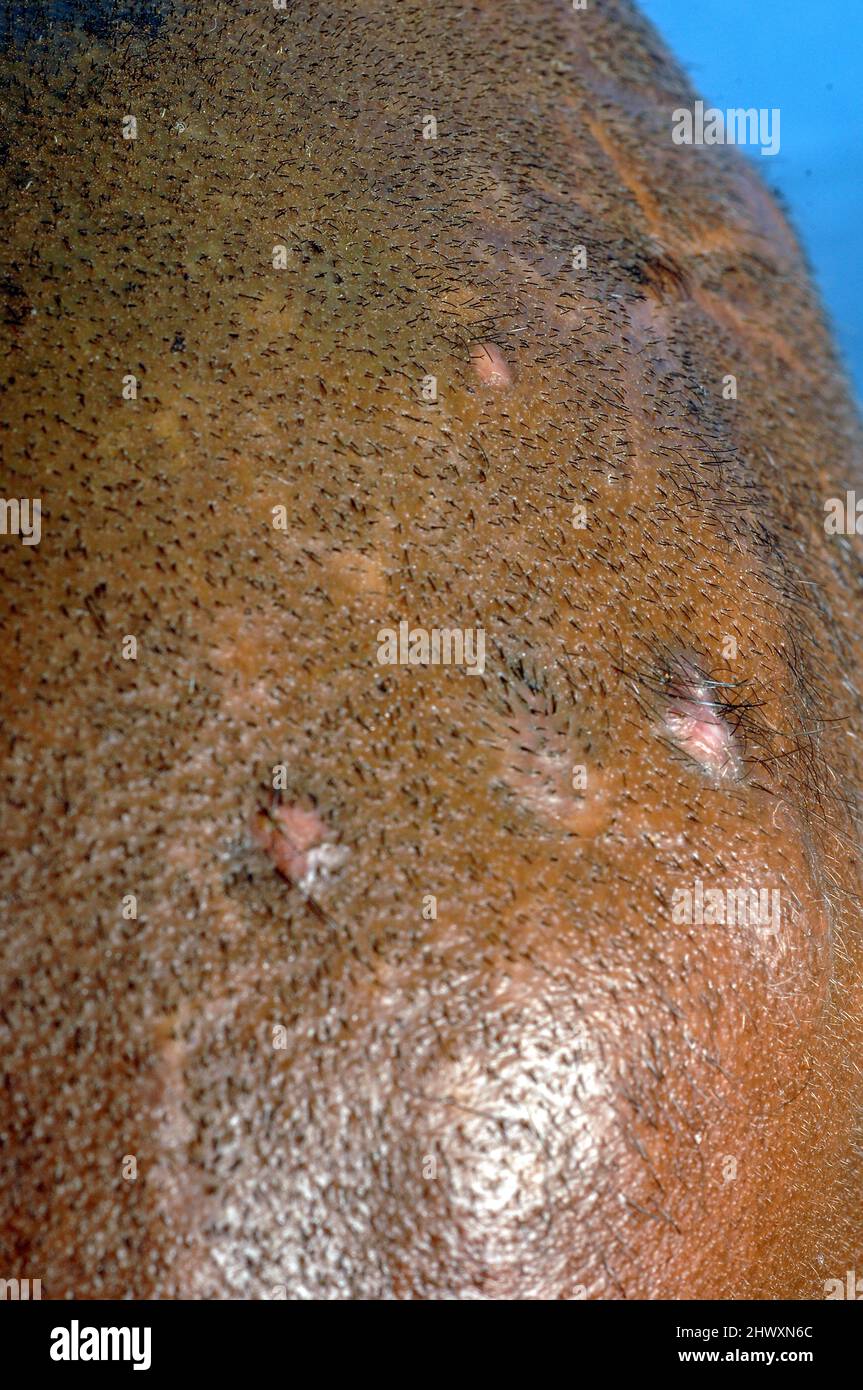 Actinomycetoma on the head of a 36 year old male. Mycetoma is an uncommon disease found in the tropics. It is a chronic, localised infection of the s Stock Photohttps://www.alamy.com/image-license-details/?v=1https://www.alamy.com/actinomycetoma-on-the-head-of-a-36-year-old-male-mycetoma-is-an-uncommon-disease-found-in-the-tropics-it-is-a-chronic-localised-infection-of-the-s-image463423364.html
Actinomycetoma on the head of a 36 year old male. Mycetoma is an uncommon disease found in the tropics. It is a chronic, localised infection of the s Stock Photohttps://www.alamy.com/image-license-details/?v=1https://www.alamy.com/actinomycetoma-on-the-head-of-a-36-year-old-male-mycetoma-is-an-uncommon-disease-found-in-the-tropics-it-is-a-chronic-localised-infection-of-the-s-image463423364.htmlRM2HWXN6C–Actinomycetoma on the head of a 36 year old male. Mycetoma is an uncommon disease found in the tropics. It is a chronic, localised infection of the s
 Actinomycetoma of the right foot. Mycetoma is an uncommon disease found in the tropics. It is a chronic, localised infection of the skin and underlyi Stock Photohttps://www.alamy.com/image-license-details/?v=1https://www.alamy.com/actinomycetoma-of-the-right-foot-mycetoma-is-an-uncommon-disease-found-in-the-tropics-it-is-a-chronic-localised-infection-of-the-skin-and-underlyi-image353682864.html
Actinomycetoma of the right foot. Mycetoma is an uncommon disease found in the tropics. It is a chronic, localised infection of the skin and underlyi Stock Photohttps://www.alamy.com/image-license-details/?v=1https://www.alamy.com/actinomycetoma-of-the-right-foot-mycetoma-is-an-uncommon-disease-found-in-the-tropics-it-is-a-chronic-localised-infection-of-the-skin-and-underlyi-image353682864.htmlRM2BFBJ2T–Actinomycetoma of the right foot. Mycetoma is an uncommon disease found in the tropics. It is a chronic, localised infection of the skin and underlyi
 A patients foot is reponding well to medical treatment for mycetoma. There are several clinical treatments available for this disease. They include su Stock Photohttps://www.alamy.com/image-license-details/?v=1https://www.alamy.com/a-patients-foot-is-reponding-well-to-medical-treatment-for-mycetoma-there-are-several-clinical-treatments-available-for-this-disease-they-include-su-image463426701.html
A patients foot is reponding well to medical treatment for mycetoma. There are several clinical treatments available for this disease. They include su Stock Photohttps://www.alamy.com/image-license-details/?v=1https://www.alamy.com/a-patients-foot-is-reponding-well-to-medical-treatment-for-mycetoma-there-are-several-clinical-treatments-available-for-this-disease-they-include-su-image463426701.htmlRM2HWXWDH–A patients foot is reponding well to medical treatment for mycetoma. There are several clinical treatments available for this disease. They include su
 Actinomycetoma affecting the skull of a middle aged male. Actinomycetoma affects both the skin and connective tissue and is the bacterial form of myce Stock Photohttps://www.alamy.com/image-license-details/?v=1https://www.alamy.com/actinomycetoma-affecting-the-skull-of-a-middle-aged-male-actinomycetoma-affects-both-the-skin-and-connective-tissue-and-is-the-bacterial-form-of-myce-image353734362.html
Actinomycetoma affecting the skull of a middle aged male. Actinomycetoma affects both the skin and connective tissue and is the bacterial form of myce Stock Photohttps://www.alamy.com/image-license-details/?v=1https://www.alamy.com/actinomycetoma-affecting-the-skull-of-a-middle-aged-male-actinomycetoma-affects-both-the-skin-and-connective-tissue-and-is-the-bacterial-form-of-myce-image353734362.htmlRM2BFDYP2–Actinomycetoma affecting the skull of a middle aged male. Actinomycetoma affects both the skin and connective tissue and is the bacterial form of myce
 Nocardia bacteria, computer illustration. These are Gram-positive branching filamentous bacteria that fragment into bacillary and coccoid forms, and cause nocardiosis (bacteria formerly identified as Nocardia asteroides complex, that are now separated into several species based on molecular studies, such as N. abscessus, N. cyriacigeorgica, N. nova and other), a rare pulmonary infection that affects people with weakened immune systems. Another type (N. brasiliensis and other) causes actinomycetoma, a tropical skin and bone infection. Stock Photohttps://www.alamy.com/image-license-details/?v=1https://www.alamy.com/nocardia-bacteria-computer-illustration-these-are-gram-positive-branching-filamentous-bacteria-that-fragment-into-bacillary-and-coccoid-forms-and-cause-nocardiosis-bacteria-formerly-identified-as-nocardia-asteroides-complex-that-are-now-separated-into-several-species-based-on-molecular-studies-such-as-n-abscessus-n-cyriacigeorgica-n-nova-and-other-a-rare-pulmonary-infection-that-affects-people-with-weakened-immune-systems-another-type-n-brasiliensis-and-other-causes-actinomycetoma-a-tropical-skin-and-bone-infection-image454450660.html
Nocardia bacteria, computer illustration. These are Gram-positive branching filamentous bacteria that fragment into bacillary and coccoid forms, and cause nocardiosis (bacteria formerly identified as Nocardia asteroides complex, that are now separated into several species based on molecular studies, such as N. abscessus, N. cyriacigeorgica, N. nova and other), a rare pulmonary infection that affects people with weakened immune systems. Another type (N. brasiliensis and other) causes actinomycetoma, a tropical skin and bone infection. Stock Photohttps://www.alamy.com/image-license-details/?v=1https://www.alamy.com/nocardia-bacteria-computer-illustration-these-are-gram-positive-branching-filamentous-bacteria-that-fragment-into-bacillary-and-coccoid-forms-and-cause-nocardiosis-bacteria-formerly-identified-as-nocardia-asteroides-complex-that-are-now-separated-into-several-species-based-on-molecular-studies-such-as-n-abscessus-n-cyriacigeorgica-n-nova-and-other-a-rare-pulmonary-infection-that-affects-people-with-weakened-immune-systems-another-type-n-brasiliensis-and-other-causes-actinomycetoma-a-tropical-skin-and-bone-infection-image454450660.htmlRF2HBA0CM–Nocardia bacteria, computer illustration. These are Gram-positive branching filamentous bacteria that fragment into bacillary and coccoid forms, and cause nocardiosis (bacteria formerly identified as Nocardia asteroides complex, that are now separated into several species based on molecular studies, such as N. abscessus, N. cyriacigeorgica, N. nova and other), a rare pulmonary infection that affects people with weakened immune systems. Another type (N. brasiliensis and other) causes actinomycetoma, a tropical skin and bone infection.
 Amputated toe due to Actinomycetoma Stock Photohttps://www.alamy.com/image-license-details/?v=1https://www.alamy.com/stock-photo-amputated-toe-due-to-actinomycetoma-49067556.html
Amputated toe due to Actinomycetoma Stock Photohttps://www.alamy.com/image-license-details/?v=1https://www.alamy.com/stock-photo-amputated-toe-due-to-actinomycetoma-49067556.htmlRMCRR64M–Amputated toe due to Actinomycetoma
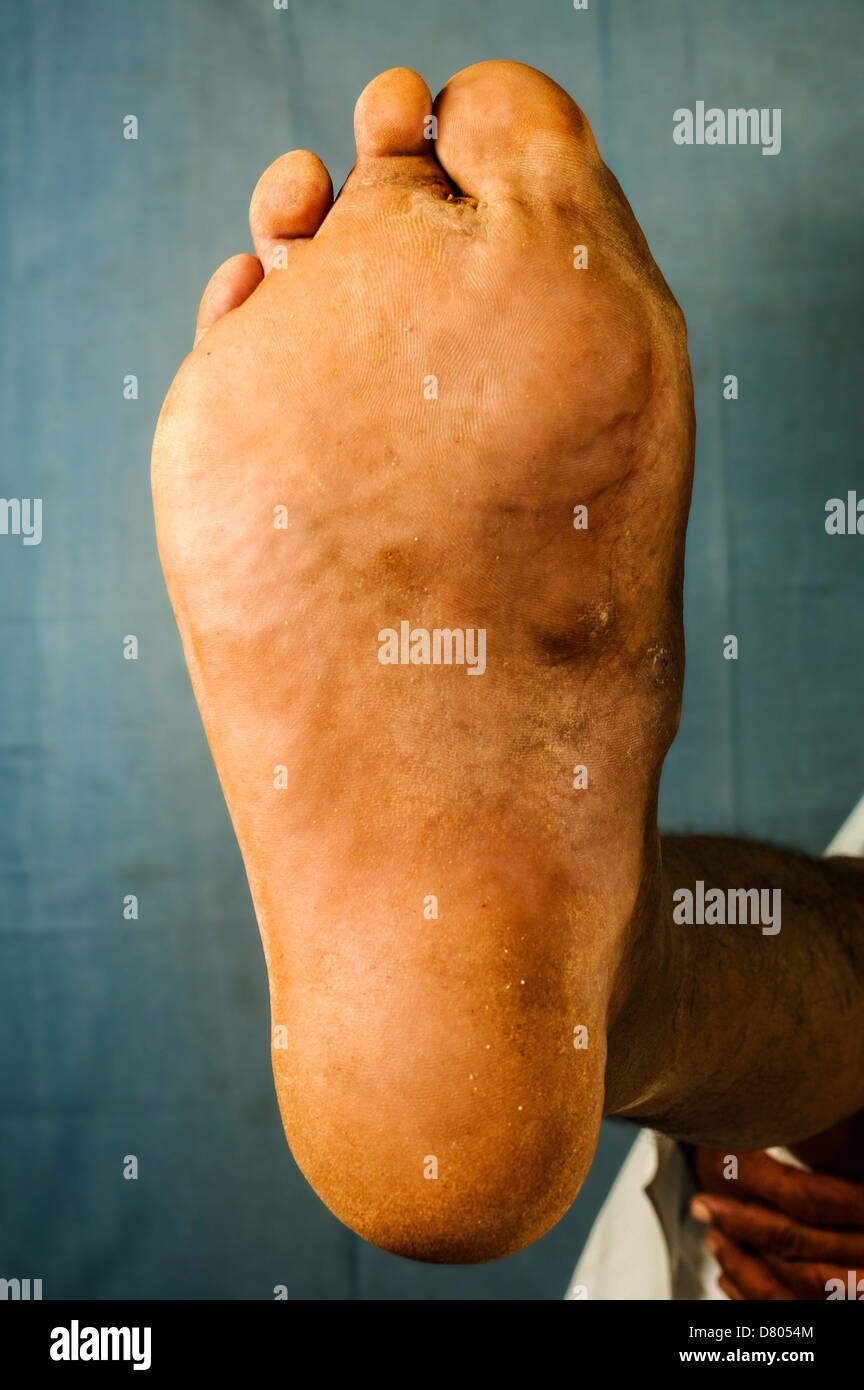 Actinomycetoma of the right foot. Stock Photohttps://www.alamy.com/image-license-details/?v=1https://www.alamy.com/stock-photo-actinomycetoma-of-the-right-foot-56552404.html
Actinomycetoma of the right foot. Stock Photohttps://www.alamy.com/image-license-details/?v=1https://www.alamy.com/stock-photo-actinomycetoma-of-the-right-foot-56552404.htmlRMD8054M–Actinomycetoma of the right foot.
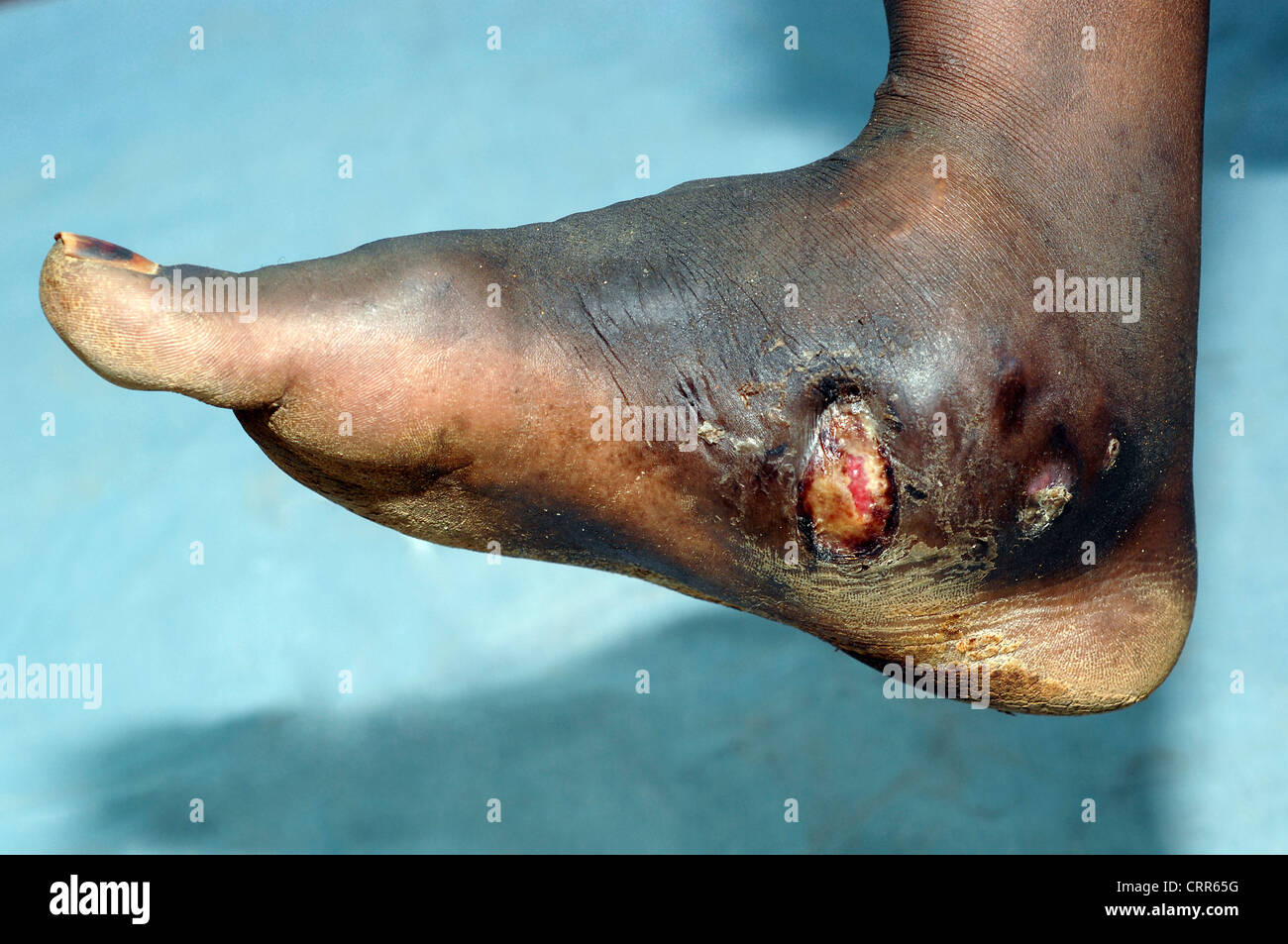 Actinomycetoma on a patients foot Stock Photohttps://www.alamy.com/image-license-details/?v=1https://www.alamy.com/stock-photo-actinomycetoma-on-a-patients-foot-49067580.html
Actinomycetoma on a patients foot Stock Photohttps://www.alamy.com/image-license-details/?v=1https://www.alamy.com/stock-photo-actinomycetoma-on-a-patients-foot-49067580.htmlRMCRR65G–Actinomycetoma on a patients foot
 Actinomycetoma affecting the skull of a middle aged male. Actinomycetoma affects both the skin and connective tissue and is the bacterial form of myce Stock Photohttps://www.alamy.com/image-license-details/?v=1https://www.alamy.com/actinomycetoma-affecting-the-skull-of-a-middle-aged-male-actinomycetoma-affects-both-the-skin-and-connective-tissue-and-is-the-bacterial-form-of-myce-image353734365.html
Actinomycetoma affecting the skull of a middle aged male. Actinomycetoma affects both the skin and connective tissue and is the bacterial form of myce Stock Photohttps://www.alamy.com/image-license-details/?v=1https://www.alamy.com/actinomycetoma-affecting-the-skull-of-a-middle-aged-male-actinomycetoma-affects-both-the-skin-and-connective-tissue-and-is-the-bacterial-form-of-myce-image353734365.htmlRM2BFDYP5–Actinomycetoma affecting the skull of a middle aged male. Actinomycetoma affects both the skin and connective tissue and is the bacterial form of myce
 Actinomycetoma of the right foot. Stock Photohttps://www.alamy.com/image-license-details/?v=1https://www.alamy.com/stock-photo-actinomycetoma-of-the-right-foot-56552449.html
Actinomycetoma of the right foot. Stock Photohttps://www.alamy.com/image-license-details/?v=1https://www.alamy.com/stock-photo-actinomycetoma-of-the-right-foot-56552449.htmlRMD80569–Actinomycetoma of the right foot.
 A patients foot is reponding well to medical treatment for mycetoma. There are several clinical treatments available for this disease. They include su Stock Photohttps://www.alamy.com/image-license-details/?v=1https://www.alamy.com/a-patients-foot-is-reponding-well-to-medical-treatment-for-mycetoma-there-are-several-clinical-treatments-available-for-this-disease-they-include-su-image463426702.html
A patients foot is reponding well to medical treatment for mycetoma. There are several clinical treatments available for this disease. They include su Stock Photohttps://www.alamy.com/image-license-details/?v=1https://www.alamy.com/a-patients-foot-is-reponding-well-to-medical-treatment-for-mycetoma-there-are-several-clinical-treatments-available-for-this-disease-they-include-su-image463426702.htmlRM2HWXWDJ–A patients foot is reponding well to medical treatment for mycetoma. There are several clinical treatments available for this disease. They include su
 Nocardia bacteria, computer illustration. These are Gram-positive branching filamentous bacteria that fragment into bacillary and coccoid forms, and cause nocardiosis (bacteria formerly identified as Nocardia asteroides complex, that are now separated into several species based on molecular studies, such as N. abscessus, N. cyriacigeorgica, N. nova and other), a rare pulmonary infection that affects people with weakened immune systems. Another type (N. brasiliensis and other) causes actinomycetoma, a tropical skin and bone infection. Stock Photohttps://www.alamy.com/image-license-details/?v=1https://www.alamy.com/nocardia-bacteria-computer-illustration-these-are-gram-positive-branching-filamentous-bacteria-that-fragment-into-bacillary-and-coccoid-forms-and-cause-nocardiosis-bacteria-formerly-identified-as-nocardia-asteroides-complex-that-are-now-separated-into-several-species-based-on-molecular-studies-such-as-n-abscessus-n-cyriacigeorgica-n-nova-and-other-a-rare-pulmonary-infection-that-affects-people-with-weakened-immune-systems-another-type-n-brasiliensis-and-other-causes-actinomycetoma-a-tropical-skin-and-bone-infection-image454450654.html
Nocardia bacteria, computer illustration. These are Gram-positive branching filamentous bacteria that fragment into bacillary and coccoid forms, and cause nocardiosis (bacteria formerly identified as Nocardia asteroides complex, that are now separated into several species based on molecular studies, such as N. abscessus, N. cyriacigeorgica, N. nova and other), a rare pulmonary infection that affects people with weakened immune systems. Another type (N. brasiliensis and other) causes actinomycetoma, a tropical skin and bone infection. Stock Photohttps://www.alamy.com/image-license-details/?v=1https://www.alamy.com/nocardia-bacteria-computer-illustration-these-are-gram-positive-branching-filamentous-bacteria-that-fragment-into-bacillary-and-coccoid-forms-and-cause-nocardiosis-bacteria-formerly-identified-as-nocardia-asteroides-complex-that-are-now-separated-into-several-species-based-on-molecular-studies-such-as-n-abscessus-n-cyriacigeorgica-n-nova-and-other-a-rare-pulmonary-infection-that-affects-people-with-weakened-immune-systems-another-type-n-brasiliensis-and-other-causes-actinomycetoma-a-tropical-skin-and-bone-infection-image454450654.htmlRF2HBA0CE–Nocardia bacteria, computer illustration. These are Gram-positive branching filamentous bacteria that fragment into bacillary and coccoid forms, and cause nocardiosis (bacteria formerly identified as Nocardia asteroides complex, that are now separated into several species based on molecular studies, such as N. abscessus, N. cyriacigeorgica, N. nova and other), a rare pulmonary infection that affects people with weakened immune systems. Another type (N. brasiliensis and other) causes actinomycetoma, a tropical skin and bone infection.
 Actinomycetoma affecting the ankle of an elderly man. Mycetoma is an uncommon disease found in the tropics. It is a chronic, localised infection of t Stock Photohttps://www.alamy.com/image-license-details/?v=1https://www.alamy.com/actinomycetoma-affecting-the-ankle-of-an-elderly-man-mycetoma-is-an-uncommon-disease-found-in-the-tropics-it-is-a-chronic-localised-infection-of-t-image353734358.html
Actinomycetoma affecting the ankle of an elderly man. Mycetoma is an uncommon disease found in the tropics. It is a chronic, localised infection of t Stock Photohttps://www.alamy.com/image-license-details/?v=1https://www.alamy.com/actinomycetoma-affecting-the-ankle-of-an-elderly-man-mycetoma-is-an-uncommon-disease-found-in-the-tropics-it-is-a-chronic-localised-infection-of-t-image353734358.htmlRM2BFDYNX–Actinomycetoma affecting the ankle of an elderly man. Mycetoma is an uncommon disease found in the tropics. It is a chronic, localised infection of t
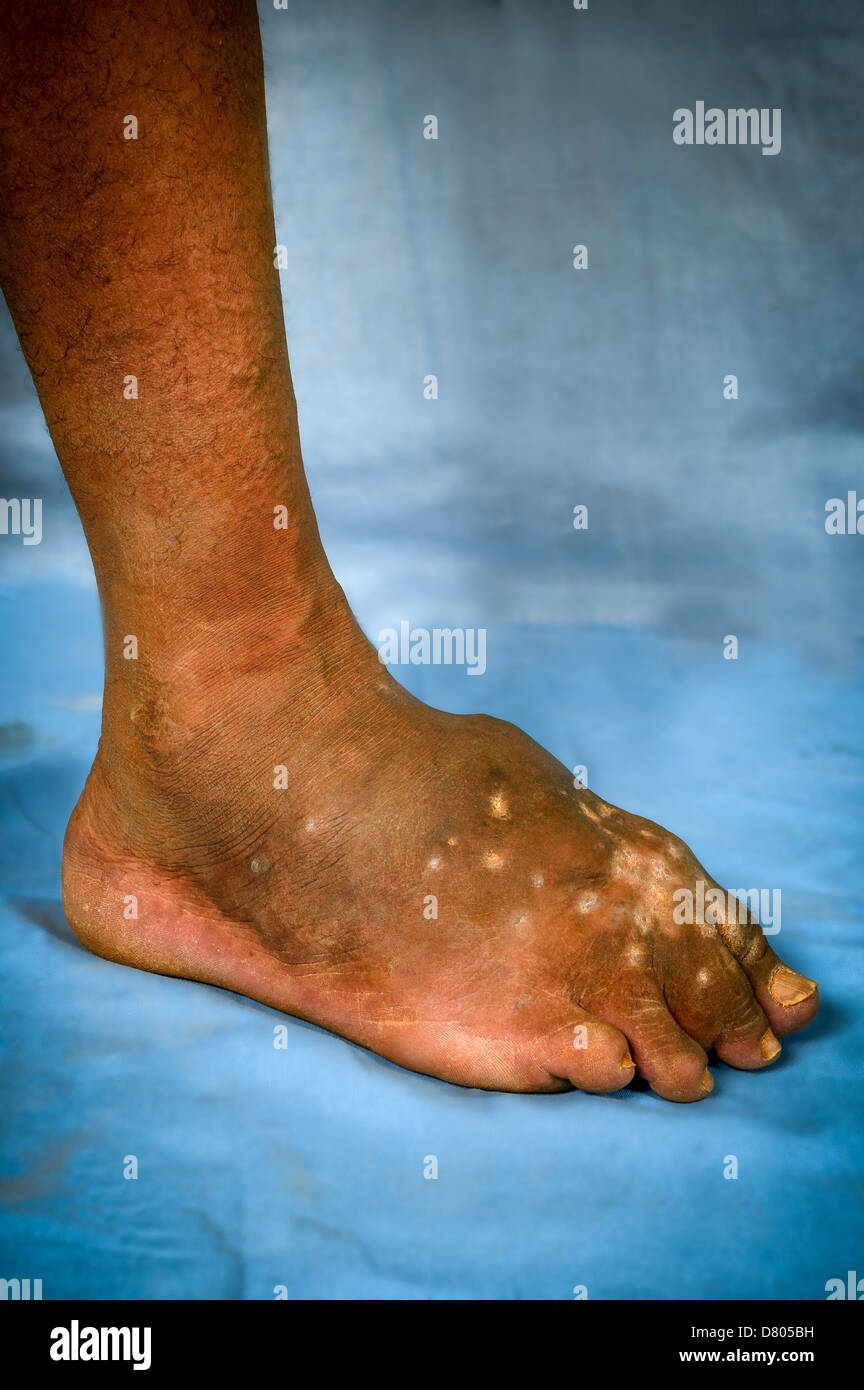 Actinomycetoma of the left foot. Stock Photohttps://www.alamy.com/image-license-details/?v=1https://www.alamy.com/stock-photo-actinomycetoma-of-the-left-foot-56552597.html
Actinomycetoma of the left foot. Stock Photohttps://www.alamy.com/image-license-details/?v=1https://www.alamy.com/stock-photo-actinomycetoma-of-the-left-foot-56552597.htmlRMD805BH–Actinomycetoma of the left foot.
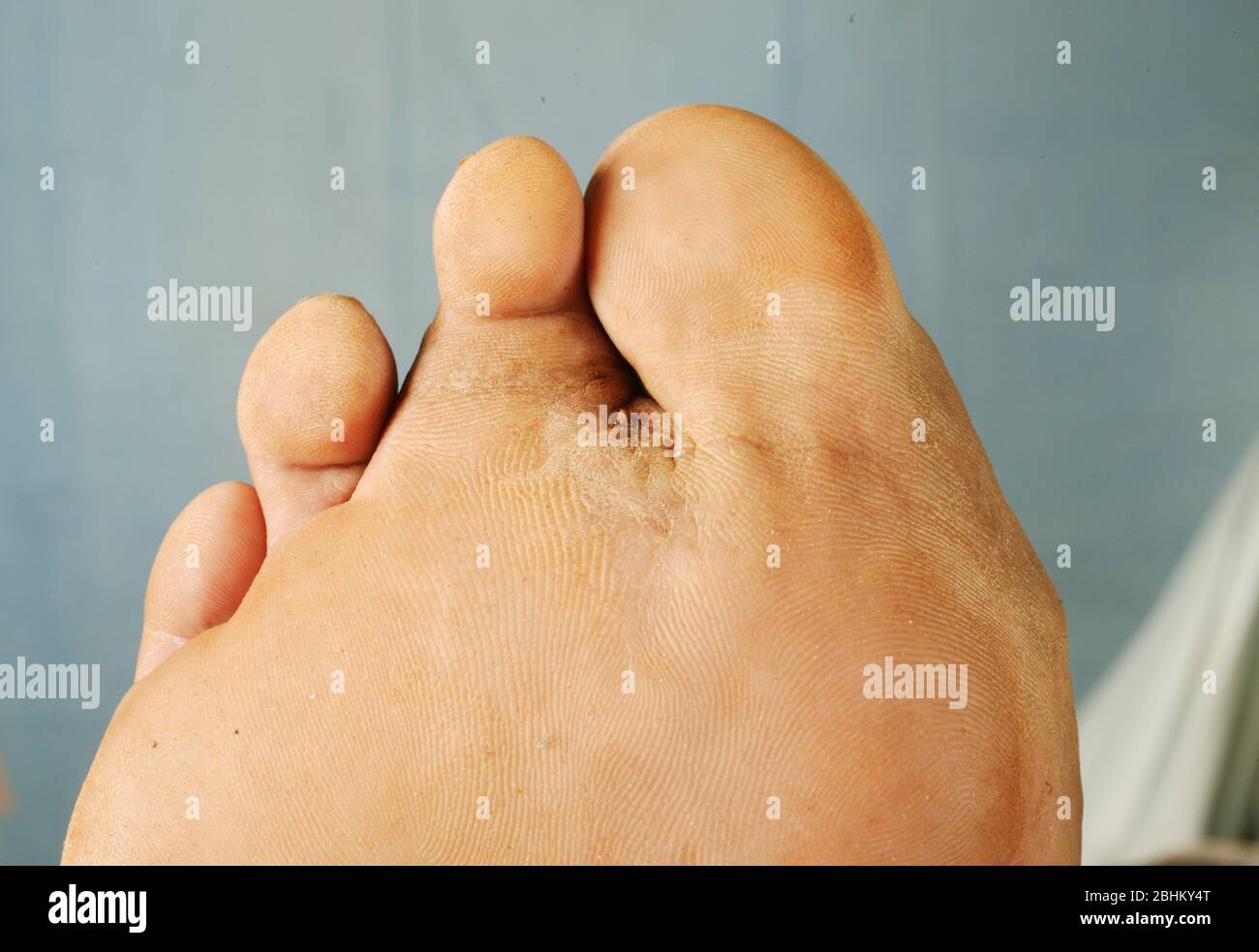 Actinomycetoma of the right foot. Mycetoma is an uncommon disease found in the tropics. It is a chronic, localised infection of the skin and underlyi Stock Photohttps://www.alamy.com/image-license-details/?v=1https://www.alamy.com/actinomycetoma-of-the-right-foot-mycetoma-is-an-uncommon-disease-found-in-the-tropics-it-is-a-chronic-localised-infection-of-the-skin-and-underlyi-image355094904.html
Actinomycetoma of the right foot. Mycetoma is an uncommon disease found in the tropics. It is a chronic, localised infection of the skin and underlyi Stock Photohttps://www.alamy.com/image-license-details/?v=1https://www.alamy.com/actinomycetoma-of-the-right-foot-mycetoma-is-an-uncommon-disease-found-in-the-tropics-it-is-a-chronic-localised-infection-of-the-skin-and-underlyi-image355094904.htmlRM2BHKY4T–Actinomycetoma of the right foot. Mycetoma is an uncommon disease found in the tropics. It is a chronic, localised infection of the skin and underlyi
 Nocardia bacteria, computer illustration. These are Gram-positive branching filamentous bacteria that fragment into bacillary and coccoid forms, and cause nocardiosis (bacteria formerly identified as Nocardia asteroides complex, that are now separated into several species based on molecular studies, such as N. abscessus, N. cyriacigeorgica, N. nova and other), a rare pulmonary infection that affects people with weakened immune systems. Another type (N. brasiliensis and other) causes actinomycetoma, a tropical skin and bone infection. Stock Photohttps://www.alamy.com/image-license-details/?v=1https://www.alamy.com/nocardia-bacteria-computer-illustration-these-are-gram-positive-branching-filamentous-bacteria-that-fragment-into-bacillary-and-coccoid-forms-and-cause-nocardiosis-bacteria-formerly-identified-as-nocardia-asteroides-complex-that-are-now-separated-into-several-species-based-on-molecular-studies-such-as-n-abscessus-n-cyriacigeorgica-n-nova-and-other-a-rare-pulmonary-infection-that-affects-people-with-weakened-immune-systems-another-type-n-brasiliensis-and-other-causes-actinomycetoma-a-tropical-skin-and-bone-infection-image454450667.html
Nocardia bacteria, computer illustration. These are Gram-positive branching filamentous bacteria that fragment into bacillary and coccoid forms, and cause nocardiosis (bacteria formerly identified as Nocardia asteroides complex, that are now separated into several species based on molecular studies, such as N. abscessus, N. cyriacigeorgica, N. nova and other), a rare pulmonary infection that affects people with weakened immune systems. Another type (N. brasiliensis and other) causes actinomycetoma, a tropical skin and bone infection. Stock Photohttps://www.alamy.com/image-license-details/?v=1https://www.alamy.com/nocardia-bacteria-computer-illustration-these-are-gram-positive-branching-filamentous-bacteria-that-fragment-into-bacillary-and-coccoid-forms-and-cause-nocardiosis-bacteria-formerly-identified-as-nocardia-asteroides-complex-that-are-now-separated-into-several-species-based-on-molecular-studies-such-as-n-abscessus-n-cyriacigeorgica-n-nova-and-other-a-rare-pulmonary-infection-that-affects-people-with-weakened-immune-systems-another-type-n-brasiliensis-and-other-causes-actinomycetoma-a-tropical-skin-and-bone-infection-image454450667.htmlRF2HBA0CY–Nocardia bacteria, computer illustration. These are Gram-positive branching filamentous bacteria that fragment into bacillary and coccoid forms, and cause nocardiosis (bacteria formerly identified as Nocardia asteroides complex, that are now separated into several species based on molecular studies, such as N. abscessus, N. cyriacigeorgica, N. nova and other), a rare pulmonary infection that affects people with weakened immune systems. Another type (N. brasiliensis and other) causes actinomycetoma, a tropical skin and bone infection.
 Actinomycetoma affecting the skull of a middle aged male. Actinomycetoma affects both the skin and connective tissue and is the bacterial form of myce Stock Photohttps://www.alamy.com/image-license-details/?v=1https://www.alamy.com/actinomycetoma-affecting-the-skull-of-a-middle-aged-male-actinomycetoma-affects-both-the-skin-and-connective-tissue-and-is-the-bacterial-form-of-myce-image355090843.html
Actinomycetoma affecting the skull of a middle aged male. Actinomycetoma affects both the skin and connective tissue and is the bacterial form of myce Stock Photohttps://www.alamy.com/image-license-details/?v=1https://www.alamy.com/actinomycetoma-affecting-the-skull-of-a-middle-aged-male-actinomycetoma-affects-both-the-skin-and-connective-tissue-and-is-the-bacterial-form-of-myce-image355090843.htmlRM2BHKNYR–Actinomycetoma affecting the skull of a middle aged male. Actinomycetoma affects both the skin and connective tissue and is the bacterial form of myce
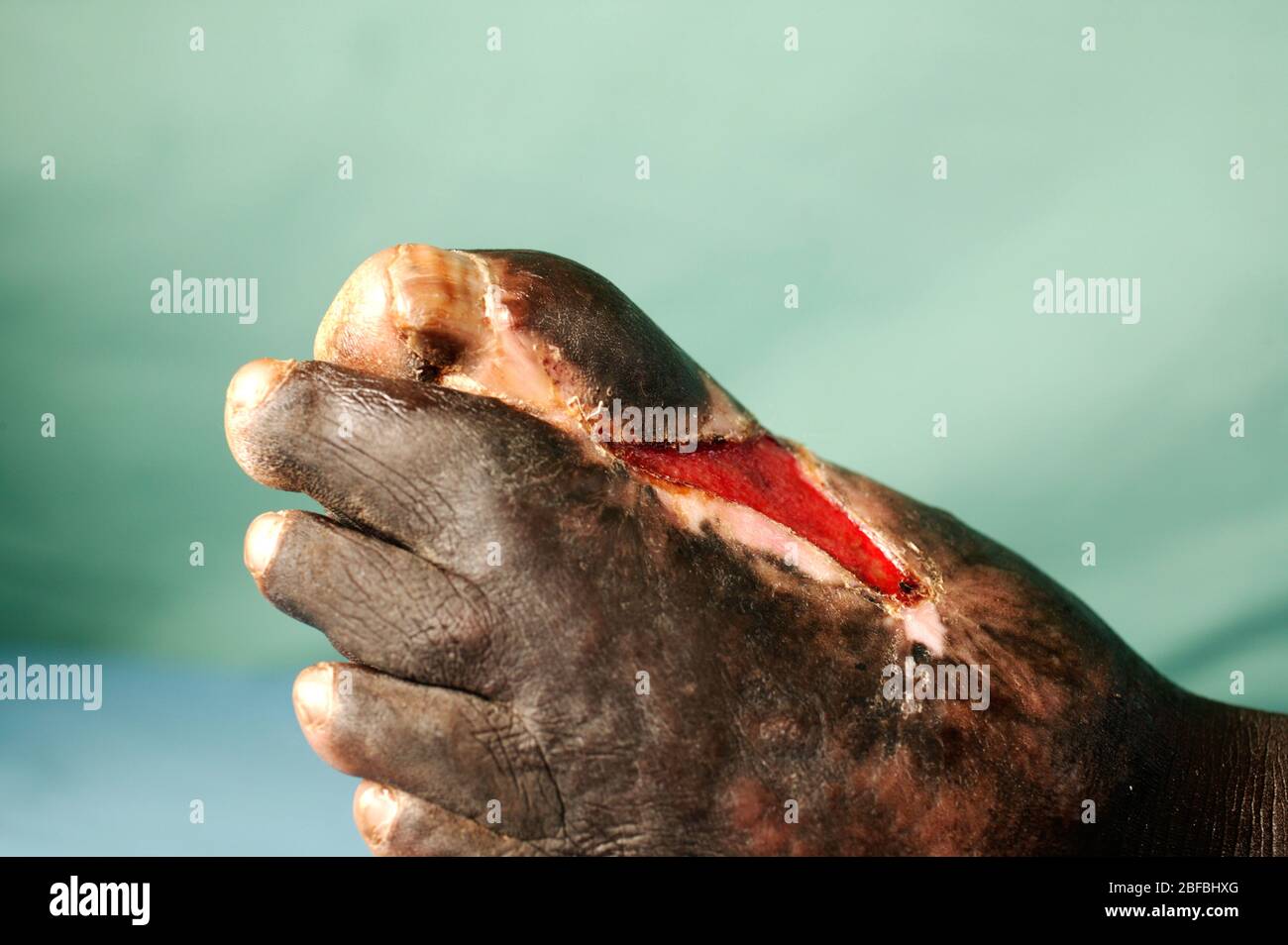 Actinomycetoma of the left foot. Mycetoma is an uncommon disease found in the tropics. It is a chronic, localised infection of the skin and underlyin Stock Photohttps://www.alamy.com/image-license-details/?v=1https://www.alamy.com/actinomycetoma-of-the-left-foot-mycetoma-is-an-uncommon-disease-found-in-the-tropics-it-is-a-chronic-localised-infection-of-the-skin-and-underlyin-image353682744.html
Actinomycetoma of the left foot. Mycetoma is an uncommon disease found in the tropics. It is a chronic, localised infection of the skin and underlyin Stock Photohttps://www.alamy.com/image-license-details/?v=1https://www.alamy.com/actinomycetoma-of-the-left-foot-mycetoma-is-an-uncommon-disease-found-in-the-tropics-it-is-a-chronic-localised-infection-of-the-skin-and-underlyin-image353682744.htmlRM2BFBHXG–Actinomycetoma of the left foot. Mycetoma is an uncommon disease found in the tropics. It is a chronic, localised infection of the skin and underlyin
 Mycetoma on the left leg of a patient. Mycetoma is an uncommon disease found in the tropics. It is a chronic, localised infection of the skin and unde Stock Photohttps://www.alamy.com/image-license-details/?v=1https://www.alamy.com/mycetoma-on-the-left-leg-of-a-patient-mycetoma-is-an-uncommon-disease-found-in-the-tropics-it-is-a-chronic-localised-infection-of-the-skin-and-unde-image353687639.html
Mycetoma on the left leg of a patient. Mycetoma is an uncommon disease found in the tropics. It is a chronic, localised infection of the skin and unde Stock Photohttps://www.alamy.com/image-license-details/?v=1https://www.alamy.com/mycetoma-on-the-left-leg-of-a-patient-mycetoma-is-an-uncommon-disease-found-in-the-tropics-it-is-a-chronic-localised-infection-of-the-skin-and-unde-image353687639.htmlRM2BFBT5B–Mycetoma on the left leg of a patient. Mycetoma is an uncommon disease found in the tropics. It is a chronic, localised infection of the skin and unde
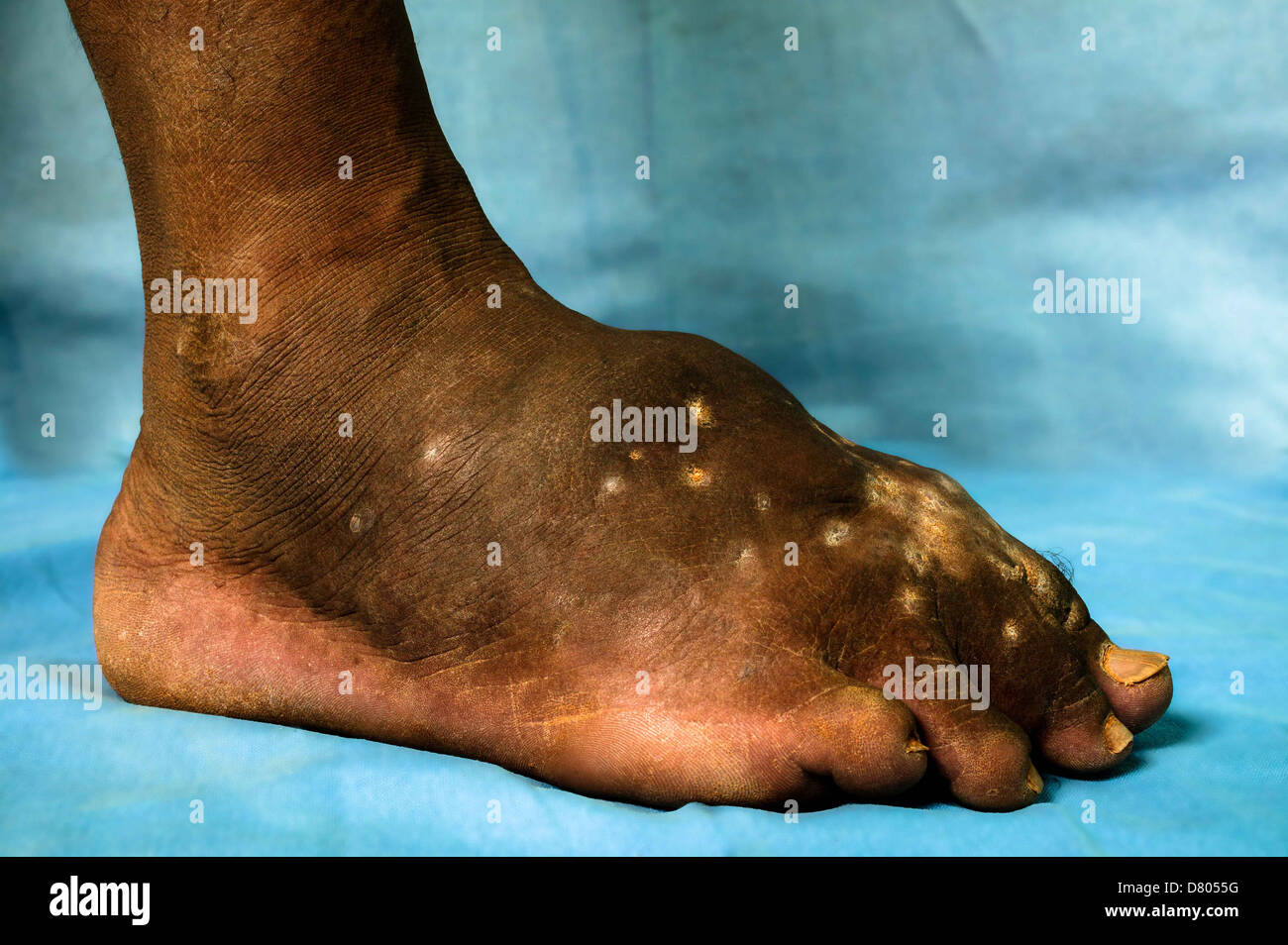 Actinomycetoma of the left foot. Stock Photohttps://www.alamy.com/image-license-details/?v=1https://www.alamy.com/stock-photo-actinomycetoma-of-the-left-foot-56552428.html
Actinomycetoma of the left foot. Stock Photohttps://www.alamy.com/image-license-details/?v=1https://www.alamy.com/stock-photo-actinomycetoma-of-the-left-foot-56552428.htmlRMD8055G–Actinomycetoma of the left foot.
 Nocardia bacteria, computer illustration. These are Gram-positive branching filamentous bacteria that fragment into bacillary and coccoid forms, and cause nocardiosis (bacteria formerly identified as Nocardia asteroides complex, that are now separated into several species based on molecular studies, such as N. abscessus, N. cyriacigeorgica, N. nova and other), a rare pulmonary infection that affects people with weakened immune systems. Another type (N. brasiliensis and other) causes actinomycetoma, a tropical skin and bone infection. Stock Photohttps://www.alamy.com/image-license-details/?v=1https://www.alamy.com/nocardia-bacteria-computer-illustration-these-are-gram-positive-branching-filamentous-bacteria-that-fragment-into-bacillary-and-coccoid-forms-and-cause-nocardiosis-bacteria-formerly-identified-as-nocardia-asteroides-complex-that-are-now-separated-into-several-species-based-on-molecular-studies-such-as-n-abscessus-n-cyriacigeorgica-n-nova-and-other-a-rare-pulmonary-infection-that-affects-people-with-weakened-immune-systems-another-type-n-brasiliensis-and-other-causes-actinomycetoma-a-tropical-skin-and-bone-infection-image454450659.html
Nocardia bacteria, computer illustration. These are Gram-positive branching filamentous bacteria that fragment into bacillary and coccoid forms, and cause nocardiosis (bacteria formerly identified as Nocardia asteroides complex, that are now separated into several species based on molecular studies, such as N. abscessus, N. cyriacigeorgica, N. nova and other), a rare pulmonary infection that affects people with weakened immune systems. Another type (N. brasiliensis and other) causes actinomycetoma, a tropical skin and bone infection. Stock Photohttps://www.alamy.com/image-license-details/?v=1https://www.alamy.com/nocardia-bacteria-computer-illustration-these-are-gram-positive-branching-filamentous-bacteria-that-fragment-into-bacillary-and-coccoid-forms-and-cause-nocardiosis-bacteria-formerly-identified-as-nocardia-asteroides-complex-that-are-now-separated-into-several-species-based-on-molecular-studies-such-as-n-abscessus-n-cyriacigeorgica-n-nova-and-other-a-rare-pulmonary-infection-that-affects-people-with-weakened-immune-systems-another-type-n-brasiliensis-and-other-causes-actinomycetoma-a-tropical-skin-and-bone-infection-image454450659.htmlRF2HBA0CK–Nocardia bacteria, computer illustration. These are Gram-positive branching filamentous bacteria that fragment into bacillary and coccoid forms, and cause nocardiosis (bacteria formerly identified as Nocardia asteroides complex, that are now separated into several species based on molecular studies, such as N. abscessus, N. cyriacigeorgica, N. nova and other), a rare pulmonary infection that affects people with weakened immune systems. Another type (N. brasiliensis and other) causes actinomycetoma, a tropical skin and bone infection.
 Mycetoma on the undersole of the right leg of a patient. Mycetoma is an uncommon disease found in the tropics. It is a chronic, localised infection of Stock Photohttps://www.alamy.com/image-license-details/?v=1https://www.alamy.com/mycetoma-on-the-undersole-of-the-right-leg-of-a-patient-mycetoma-is-an-uncommon-disease-found-in-the-tropics-it-is-a-chronic-localised-infection-of-image353687642.html
Mycetoma on the undersole of the right leg of a patient. Mycetoma is an uncommon disease found in the tropics. It is a chronic, localised infection of Stock Photohttps://www.alamy.com/image-license-details/?v=1https://www.alamy.com/mycetoma-on-the-undersole-of-the-right-leg-of-a-patient-mycetoma-is-an-uncommon-disease-found-in-the-tropics-it-is-a-chronic-localised-infection-of-image353687642.htmlRM2BFBT5E–Mycetoma on the undersole of the right leg of a patient. Mycetoma is an uncommon disease found in the tropics. It is a chronic, localised infection of
 A foot with actinomycetoma. Stock Photohttps://www.alamy.com/image-license-details/?v=1https://www.alamy.com/stock-photo-a-foot-with-actinomycetoma-56553046.html
A foot with actinomycetoma. Stock Photohttps://www.alamy.com/image-license-details/?v=1https://www.alamy.com/stock-photo-a-foot-with-actinomycetoma-56553046.htmlRMD805YJ–A foot with actinomycetoma.
 Nocardia bacteria, computer illustration. These are Gram-positive branching filamentous bacteria that fragment into bacillary and coccoid forms, and cause nocardiosis (bacteria formerly identified as Nocardia asteroides complex, that are now separated into several species based on molecular studies, such as N. abscessus, N. cyriacigeorgica, N. nova and other), a rare pulmonary infection that affects people with weakened immune systems. Another type (N. brasiliensis and other) causes actinomycetoma, a tropical skin and bone infection. Stock Photohttps://www.alamy.com/image-license-details/?v=1https://www.alamy.com/nocardia-bacteria-computer-illustration-these-are-gram-positive-branching-filamentous-bacteria-that-fragment-into-bacillary-and-coccoid-forms-and-cause-nocardiosis-bacteria-formerly-identified-as-nocardia-asteroides-complex-that-are-now-separated-into-several-species-based-on-molecular-studies-such-as-n-abscessus-n-cyriacigeorgica-n-nova-and-other-a-rare-pulmonary-infection-that-affects-people-with-weakened-immune-systems-another-type-n-brasiliensis-and-other-causes-actinomycetoma-a-tropical-skin-and-bone-infection-image454450644.html
Nocardia bacteria, computer illustration. These are Gram-positive branching filamentous bacteria that fragment into bacillary and coccoid forms, and cause nocardiosis (bacteria formerly identified as Nocardia asteroides complex, that are now separated into several species based on molecular studies, such as N. abscessus, N. cyriacigeorgica, N. nova and other), a rare pulmonary infection that affects people with weakened immune systems. Another type (N. brasiliensis and other) causes actinomycetoma, a tropical skin and bone infection. Stock Photohttps://www.alamy.com/image-license-details/?v=1https://www.alamy.com/nocardia-bacteria-computer-illustration-these-are-gram-positive-branching-filamentous-bacteria-that-fragment-into-bacillary-and-coccoid-forms-and-cause-nocardiosis-bacteria-formerly-identified-as-nocardia-asteroides-complex-that-are-now-separated-into-several-species-based-on-molecular-studies-such-as-n-abscessus-n-cyriacigeorgica-n-nova-and-other-a-rare-pulmonary-infection-that-affects-people-with-weakened-immune-systems-another-type-n-brasiliensis-and-other-causes-actinomycetoma-a-tropical-skin-and-bone-infection-image454450644.htmlRF2HBA0C4–Nocardia bacteria, computer illustration. These are Gram-positive branching filamentous bacteria that fragment into bacillary and coccoid forms, and cause nocardiosis (bacteria formerly identified as Nocardia asteroides complex, that are now separated into several species based on molecular studies, such as N. abscessus, N. cyriacigeorgica, N. nova and other), a rare pulmonary infection that affects people with weakened immune systems. Another type (N. brasiliensis and other) causes actinomycetoma, a tropical skin and bone infection.
 Mycetoma on the right right foot of a patient. Mycetoma is an uncommon disease found in the tropics. It is a chronic, localised infection of the skin Stock Photohttps://www.alamy.com/image-license-details/?v=1https://www.alamy.com/mycetoma-on-the-right-right-foot-of-a-patient-mycetoma-is-an-uncommon-disease-found-in-the-tropics-it-is-a-chronic-localised-infection-of-the-skin-image353687617.html
Mycetoma on the right right foot of a patient. Mycetoma is an uncommon disease found in the tropics. It is a chronic, localised infection of the skin Stock Photohttps://www.alamy.com/image-license-details/?v=1https://www.alamy.com/mycetoma-on-the-right-right-foot-of-a-patient-mycetoma-is-an-uncommon-disease-found-in-the-tropics-it-is-a-chronic-localised-infection-of-the-skin-image353687617.htmlRM2BFBT4H–Mycetoma on the right right foot of a patient. Mycetoma is an uncommon disease found in the tropics. It is a chronic, localised infection of the skin
 A patients foot is reponding well to medical treatment for mycetoma. There are several clinical treatments available for this disease. They include su Stock Photohttps://www.alamy.com/image-license-details/?v=1https://www.alamy.com/a-patients-foot-is-reponding-well-to-medical-treatment-for-mycetoma-there-are-several-clinical-treatments-available-for-this-disease-they-include-su-image353749535.html
A patients foot is reponding well to medical treatment for mycetoma. There are several clinical treatments available for this disease. They include su Stock Photohttps://www.alamy.com/image-license-details/?v=1https://www.alamy.com/a-patients-foot-is-reponding-well-to-medical-treatment-for-mycetoma-there-are-several-clinical-treatments-available-for-this-disease-they-include-su-image353749535.htmlRM2BFEK3Y–A patients foot is reponding well to medical treatment for mycetoma. There are several clinical treatments available for this disease. They include su
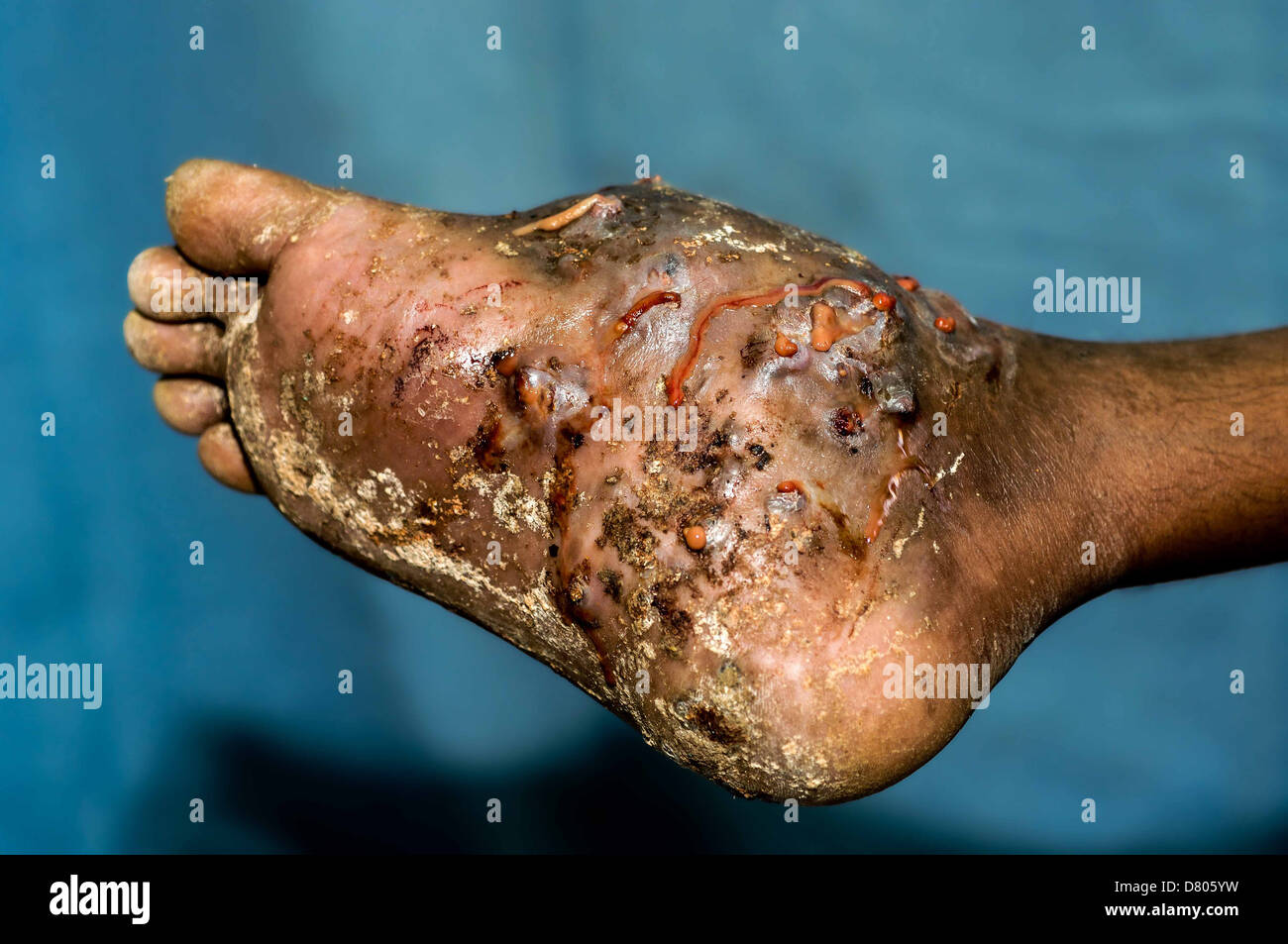 A foot with actinomycetoma. Stock Photohttps://www.alamy.com/image-license-details/?v=1https://www.alamy.com/stock-photo-a-foot-with-actinomycetoma-56553053.html
A foot with actinomycetoma. Stock Photohttps://www.alamy.com/image-license-details/?v=1https://www.alamy.com/stock-photo-a-foot-with-actinomycetoma-56553053.htmlRMD805YW–A foot with actinomycetoma.
 Nocardia bacteria, computer illustration. These are Gram-positive branching filamentous bacteria that fragment into bacillary and coccoid forms, and cause nocardiosis (bacteria formerly identified as Nocardia asteroides complex, that are now separated into several species based on molecular studies, such as N. abscessus, N. cyriacigeorgica, N. nova and other), a rare pulmonary infection that affects people with weakened immune systems. Another type (N. brasiliensis and other) causes actinomycetoma, a tropical skin and bone infection. Stock Photohttps://www.alamy.com/image-license-details/?v=1https://www.alamy.com/nocardia-bacteria-computer-illustration-these-are-gram-positive-branching-filamentous-bacteria-that-fragment-into-bacillary-and-coccoid-forms-and-cause-nocardiosis-bacteria-formerly-identified-as-nocardia-asteroides-complex-that-are-now-separated-into-several-species-based-on-molecular-studies-such-as-n-abscessus-n-cyriacigeorgica-n-nova-and-other-a-rare-pulmonary-infection-that-affects-people-with-weakened-immune-systems-another-type-n-brasiliensis-and-other-causes-actinomycetoma-a-tropical-skin-and-bone-infection-image454450661.html
Nocardia bacteria, computer illustration. These are Gram-positive branching filamentous bacteria that fragment into bacillary and coccoid forms, and cause nocardiosis (bacteria formerly identified as Nocardia asteroides complex, that are now separated into several species based on molecular studies, such as N. abscessus, N. cyriacigeorgica, N. nova and other), a rare pulmonary infection that affects people with weakened immune systems. Another type (N. brasiliensis and other) causes actinomycetoma, a tropical skin and bone infection. Stock Photohttps://www.alamy.com/image-license-details/?v=1https://www.alamy.com/nocardia-bacteria-computer-illustration-these-are-gram-positive-branching-filamentous-bacteria-that-fragment-into-bacillary-and-coccoid-forms-and-cause-nocardiosis-bacteria-formerly-identified-as-nocardia-asteroides-complex-that-are-now-separated-into-several-species-based-on-molecular-studies-such-as-n-abscessus-n-cyriacigeorgica-n-nova-and-other-a-rare-pulmonary-infection-that-affects-people-with-weakened-immune-systems-another-type-n-brasiliensis-and-other-causes-actinomycetoma-a-tropical-skin-and-bone-infection-image454450661.htmlRF2HBA0CN–Nocardia bacteria, computer illustration. These are Gram-positive branching filamentous bacteria that fragment into bacillary and coccoid forms, and cause nocardiosis (bacteria formerly identified as Nocardia asteroides complex, that are now separated into several species based on molecular studies, such as N. abscessus, N. cyriacigeorgica, N. nova and other), a rare pulmonary infection that affects people with weakened immune systems. Another type (N. brasiliensis and other) causes actinomycetoma, a tropical skin and bone infection.
 A patients foot is reponding well to medical treatment for mycetoma. There are several clinical treatments available for this disease. They include su Stock Photohttps://www.alamy.com/image-license-details/?v=1https://www.alamy.com/a-patients-foot-is-reponding-well-to-medical-treatment-for-mycetoma-there-are-several-clinical-treatments-available-for-this-disease-they-include-su-image353749531.html
A patients foot is reponding well to medical treatment for mycetoma. There are several clinical treatments available for this disease. They include su Stock Photohttps://www.alamy.com/image-license-details/?v=1https://www.alamy.com/a-patients-foot-is-reponding-well-to-medical-treatment-for-mycetoma-there-are-several-clinical-treatments-available-for-this-disease-they-include-su-image353749531.htmlRM2BFEK3R–A patients foot is reponding well to medical treatment for mycetoma. There are several clinical treatments available for this disease. They include su
 Actinomycetoma affecting the ankle of an elderly man from Sudan. Stock Photohttps://www.alamy.com/image-license-details/?v=1https://www.alamy.com/stock-photo-actinomycetoma-affecting-the-ankle-of-an-elderly-man-from-sudan-56552164.html
Actinomycetoma affecting the ankle of an elderly man from Sudan. Stock Photohttps://www.alamy.com/image-license-details/?v=1https://www.alamy.com/stock-photo-actinomycetoma-affecting-the-ankle-of-an-elderly-man-from-sudan-56552164.htmlRMD804T4–Actinomycetoma affecting the ankle of an elderly man from Sudan.
 Nocardia bacteria, computer illustration. These are Gram-positive branching filamentous bacteria that fragment into bacillary and coccoid forms, and cause nocardiosis (bacteria formerly identified as Nocardia asteroides complex, that are now separated into several species based on molecular studies, such as N. abscessus, N. cyriacigeorgica, N. nova and other), a rare pulmonary infection that affects people with weakened immune systems. Another type (N. brasiliensis and other) causes actinomycetoma, a tropical skin and bone infection. Stock Photohttps://www.alamy.com/image-license-details/?v=1https://www.alamy.com/nocardia-bacteria-computer-illustration-these-are-gram-positive-branching-filamentous-bacteria-that-fragment-into-bacillary-and-coccoid-forms-and-cause-nocardiosis-bacteria-formerly-identified-as-nocardia-asteroides-complex-that-are-now-separated-into-several-species-based-on-molecular-studies-such-as-n-abscessus-n-cyriacigeorgica-n-nova-and-other-a-rare-pulmonary-infection-that-affects-people-with-weakened-immune-systems-another-type-n-brasiliensis-and-other-causes-actinomycetoma-a-tropical-skin-and-bone-infection-image454450658.html
Nocardia bacteria, computer illustration. These are Gram-positive branching filamentous bacteria that fragment into bacillary and coccoid forms, and cause nocardiosis (bacteria formerly identified as Nocardia asteroides complex, that are now separated into several species based on molecular studies, such as N. abscessus, N. cyriacigeorgica, N. nova and other), a rare pulmonary infection that affects people with weakened immune systems. Another type (N. brasiliensis and other) causes actinomycetoma, a tropical skin and bone infection. Stock Photohttps://www.alamy.com/image-license-details/?v=1https://www.alamy.com/nocardia-bacteria-computer-illustration-these-are-gram-positive-branching-filamentous-bacteria-that-fragment-into-bacillary-and-coccoid-forms-and-cause-nocardiosis-bacteria-formerly-identified-as-nocardia-asteroides-complex-that-are-now-separated-into-several-species-based-on-molecular-studies-such-as-n-abscessus-n-cyriacigeorgica-n-nova-and-other-a-rare-pulmonary-infection-that-affects-people-with-weakened-immune-systems-another-type-n-brasiliensis-and-other-causes-actinomycetoma-a-tropical-skin-and-bone-infection-image454450658.htmlRF2HBA0CJ–Nocardia bacteria, computer illustration. These are Gram-positive branching filamentous bacteria that fragment into bacillary and coccoid forms, and cause nocardiosis (bacteria formerly identified as Nocardia asteroides complex, that are now separated into several species based on molecular studies, such as N. abscessus, N. cyriacigeorgica, N. nova and other), a rare pulmonary infection that affects people with weakened immune systems. Another type (N. brasiliensis and other) causes actinomycetoma, a tropical skin and bone infection.
 A patients foot is reponding well to medical treatment for mycetoma. There are several clinical treatments available for this disease. They include su Stock Photohttps://www.alamy.com/image-license-details/?v=1https://www.alamy.com/a-patients-foot-is-reponding-well-to-medical-treatment-for-mycetoma-there-are-several-clinical-treatments-available-for-this-disease-they-include-su-image353749526.html
A patients foot is reponding well to medical treatment for mycetoma. There are several clinical treatments available for this disease. They include su Stock Photohttps://www.alamy.com/image-license-details/?v=1https://www.alamy.com/a-patients-foot-is-reponding-well-to-medical-treatment-for-mycetoma-there-are-several-clinical-treatments-available-for-this-disease-they-include-su-image353749526.htmlRM2BFEK3J–A patients foot is reponding well to medical treatment for mycetoma. There are several clinical treatments available for this disease. They include su
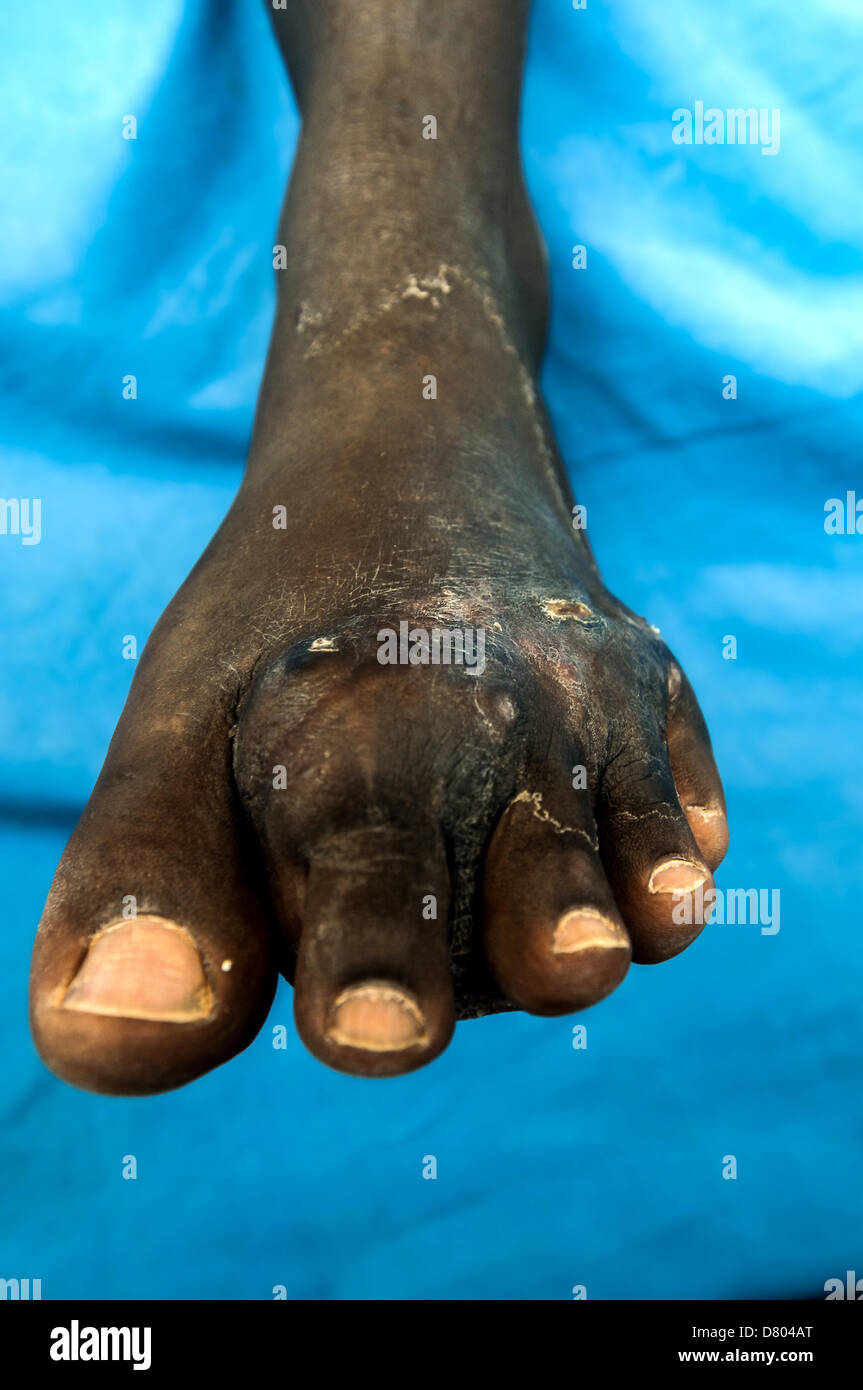 Actinomycetoma on the left foot of a 47 year old male. Stock Photohttps://www.alamy.com/image-license-details/?v=1https://www.alamy.com/stock-photo-actinomycetoma-on-the-left-foot-of-a-47-year-old-male-56551792.html
Actinomycetoma on the left foot of a 47 year old male. Stock Photohttps://www.alamy.com/image-license-details/?v=1https://www.alamy.com/stock-photo-actinomycetoma-on-the-left-foot-of-a-47-year-old-male-56551792.htmlRMD804AT–Actinomycetoma on the left foot of a 47 year old male.
 Nocardia bacteria, computer illustration. These are Gram-positive branching filamentous bacteria that fragment into bacillary and coccoid forms, and cause nocardiosis (bacteria formerly identified as Nocardia asteroides complex, that are now separated into several species based on molecular studies, such as N. abscessus, N. cyriacigeorgica, N. nova and other), a rare pulmonary infection that affects people with weakened immune systems. Another type (N. brasiliensis and other) causes actinomycetoma, a tropical skin and bone infection. Stock Photohttps://www.alamy.com/image-license-details/?v=1https://www.alamy.com/nocardia-bacteria-computer-illustration-these-are-gram-positive-branching-filamentous-bacteria-that-fragment-into-bacillary-and-coccoid-forms-and-cause-nocardiosis-bacteria-formerly-identified-as-nocardia-asteroides-complex-that-are-now-separated-into-several-species-based-on-molecular-studies-such-as-n-abscessus-n-cyriacigeorgica-n-nova-and-other-a-rare-pulmonary-infection-that-affects-people-with-weakened-immune-systems-another-type-n-brasiliensis-and-other-causes-actinomycetoma-a-tropical-skin-and-bone-infection-image454450641.html
Nocardia bacteria, computer illustration. These are Gram-positive branching filamentous bacteria that fragment into bacillary and coccoid forms, and cause nocardiosis (bacteria formerly identified as Nocardia asteroides complex, that are now separated into several species based on molecular studies, such as N. abscessus, N. cyriacigeorgica, N. nova and other), a rare pulmonary infection that affects people with weakened immune systems. Another type (N. brasiliensis and other) causes actinomycetoma, a tropical skin and bone infection. Stock Photohttps://www.alamy.com/image-license-details/?v=1https://www.alamy.com/nocardia-bacteria-computer-illustration-these-are-gram-positive-branching-filamentous-bacteria-that-fragment-into-bacillary-and-coccoid-forms-and-cause-nocardiosis-bacteria-formerly-identified-as-nocardia-asteroides-complex-that-are-now-separated-into-several-species-based-on-molecular-studies-such-as-n-abscessus-n-cyriacigeorgica-n-nova-and-other-a-rare-pulmonary-infection-that-affects-people-with-weakened-immune-systems-another-type-n-brasiliensis-and-other-causes-actinomycetoma-a-tropical-skin-and-bone-infection-image454450641.htmlRF2HBA0C1–Nocardia bacteria, computer illustration. These are Gram-positive branching filamentous bacteria that fragment into bacillary and coccoid forms, and cause nocardiosis (bacteria formerly identified as Nocardia asteroides complex, that are now separated into several species based on molecular studies, such as N. abscessus, N. cyriacigeorgica, N. nova and other), a rare pulmonary infection that affects people with weakened immune systems. Another type (N. brasiliensis and other) causes actinomycetoma, a tropical skin and bone infection.
 Actinomycetoma affecting the skull of a middle aged male. Stock Photohttps://www.alamy.com/image-license-details/?v=1https://www.alamy.com/stock-photo-actinomycetoma-affecting-the-skull-of-a-middle-aged-male-56552771.html
Actinomycetoma affecting the skull of a middle aged male. Stock Photohttps://www.alamy.com/image-license-details/?v=1https://www.alamy.com/stock-photo-actinomycetoma-affecting-the-skull-of-a-middle-aged-male-56552771.htmlRMD805HR–Actinomycetoma affecting the skull of a middle aged male.
 Nocardia bacteria, computer illustration. These are Gram-positive branching filamentous bacteria that fragment into bacillary and coccoid forms, and cause nocardiosis (bacteria formerly identified as Nocardia asteroides complex, that are now separated into several species based on molecular studies, such as N. abscessus, N. cyriacigeorgica, N. nova and other), a rare pulmonary infection that affects people with weakened immune systems. Another type (N. brasiliensis and other) causes actinomycetoma, a tropical skin and bone infection. Stock Photohttps://www.alamy.com/image-license-details/?v=1https://www.alamy.com/nocardia-bacteria-computer-illustration-these-are-gram-positive-branching-filamentous-bacteria-that-fragment-into-bacillary-and-coccoid-forms-and-cause-nocardiosis-bacteria-formerly-identified-as-nocardia-asteroides-complex-that-are-now-separated-into-several-species-based-on-molecular-studies-such-as-n-abscessus-n-cyriacigeorgica-n-nova-and-other-a-rare-pulmonary-infection-that-affects-people-with-weakened-immune-systems-another-type-n-brasiliensis-and-other-causes-actinomycetoma-a-tropical-skin-and-bone-infection-image454450671.html
Nocardia bacteria, computer illustration. These are Gram-positive branching filamentous bacteria that fragment into bacillary and coccoid forms, and cause nocardiosis (bacteria formerly identified as Nocardia asteroides complex, that are now separated into several species based on molecular studies, such as N. abscessus, N. cyriacigeorgica, N. nova and other), a rare pulmonary infection that affects people with weakened immune systems. Another type (N. brasiliensis and other) causes actinomycetoma, a tropical skin and bone infection. Stock Photohttps://www.alamy.com/image-license-details/?v=1https://www.alamy.com/nocardia-bacteria-computer-illustration-these-are-gram-positive-branching-filamentous-bacteria-that-fragment-into-bacillary-and-coccoid-forms-and-cause-nocardiosis-bacteria-formerly-identified-as-nocardia-asteroides-complex-that-are-now-separated-into-several-species-based-on-molecular-studies-such-as-n-abscessus-n-cyriacigeorgica-n-nova-and-other-a-rare-pulmonary-infection-that-affects-people-with-weakened-immune-systems-another-type-n-brasiliensis-and-other-causes-actinomycetoma-a-tropical-skin-and-bone-infection-image454450671.htmlRF2HBA0D3–Nocardia bacteria, computer illustration. These are Gram-positive branching filamentous bacteria that fragment into bacillary and coccoid forms, and cause nocardiosis (bacteria formerly identified as Nocardia asteroides complex, that are now separated into several species based on molecular studies, such as N. abscessus, N. cyriacigeorgica, N. nova and other), a rare pulmonary infection that affects people with weakened immune systems. Another type (N. brasiliensis and other) causes actinomycetoma, a tropical skin and bone infection.
 Actinomycetoma affecting the skull of a middle aged male. Stock Photohttps://www.alamy.com/image-license-details/?v=1https://www.alamy.com/stock-photo-actinomycetoma-affecting-the-skull-of-a-middle-aged-male-56552774.html
Actinomycetoma affecting the skull of a middle aged male. Stock Photohttps://www.alamy.com/image-license-details/?v=1https://www.alamy.com/stock-photo-actinomycetoma-affecting-the-skull-of-a-middle-aged-male-56552774.htmlRMD805HX–Actinomycetoma affecting the skull of a middle aged male.
 Nocardia bacteria, computer illustration. These are Gram-positive branching filamentous bacteria that fragment into bacillary and coccoid forms, and cause nocardiosis (bacteria formerly identified as Nocardia asteroides complex, that are now separated into several species based on molecular studies, such as N. abscessus, N. cyriacigeorgica, N. nova and other), a rare pulmonary infection that affects people with weakened immune systems. Another type (N. brasiliensis and other) causes actinomycetoma, a tropical skin and bone infection. Stock Photohttps://www.alamy.com/image-license-details/?v=1https://www.alamy.com/nocardia-bacteria-computer-illustration-these-are-gram-positive-branching-filamentous-bacteria-that-fragment-into-bacillary-and-coccoid-forms-and-cause-nocardiosis-bacteria-formerly-identified-as-nocardia-asteroides-complex-that-are-now-separated-into-several-species-based-on-molecular-studies-such-as-n-abscessus-n-cyriacigeorgica-n-nova-and-other-a-rare-pulmonary-infection-that-affects-people-with-weakened-immune-systems-another-type-n-brasiliensis-and-other-causes-actinomycetoma-a-tropical-skin-and-bone-infection-image454450649.html
Nocardia bacteria, computer illustration. These are Gram-positive branching filamentous bacteria that fragment into bacillary and coccoid forms, and cause nocardiosis (bacteria formerly identified as Nocardia asteroides complex, that are now separated into several species based on molecular studies, such as N. abscessus, N. cyriacigeorgica, N. nova and other), a rare pulmonary infection that affects people with weakened immune systems. Another type (N. brasiliensis and other) causes actinomycetoma, a tropical skin and bone infection. Stock Photohttps://www.alamy.com/image-license-details/?v=1https://www.alamy.com/nocardia-bacteria-computer-illustration-these-are-gram-positive-branching-filamentous-bacteria-that-fragment-into-bacillary-and-coccoid-forms-and-cause-nocardiosis-bacteria-formerly-identified-as-nocardia-asteroides-complex-that-are-now-separated-into-several-species-based-on-molecular-studies-such-as-n-abscessus-n-cyriacigeorgica-n-nova-and-other-a-rare-pulmonary-infection-that-affects-people-with-weakened-immune-systems-another-type-n-brasiliensis-and-other-causes-actinomycetoma-a-tropical-skin-and-bone-infection-image454450649.htmlRF2HBA0C9–Nocardia bacteria, computer illustration. These are Gram-positive branching filamentous bacteria that fragment into bacillary and coccoid forms, and cause nocardiosis (bacteria formerly identified as Nocardia asteroides complex, that are now separated into several species based on molecular studies, such as N. abscessus, N. cyriacigeorgica, N. nova and other), a rare pulmonary infection that affects people with weakened immune systems. Another type (N. brasiliensis and other) causes actinomycetoma, a tropical skin and bone infection.
 Actinomycetoma on the head of a 36 year old male. Stock Photohttps://www.alamy.com/image-license-details/?v=1https://www.alamy.com/stock-photo-actinomycetoma-on-the-head-of-a-36-year-old-male-56552779.html
Actinomycetoma on the head of a 36 year old male. Stock Photohttps://www.alamy.com/image-license-details/?v=1https://www.alamy.com/stock-photo-actinomycetoma-on-the-head-of-a-36-year-old-male-56552779.htmlRMD805J3–Actinomycetoma on the head of a 36 year old male.
 Nocardia bacteria, computer illustration. These are Gram-positive branching filamentous bacteria that fragment into bacillary and coccoid forms, and cause nocardiosis (bacteria formerly identified as Nocardia asteroides complex, that are now separated into several species based on molecular studies, such as N. abscessus, N. cyriacigeorgica, N. nova and other), a rare pulmonary infection that affects people with weakened immune systems. Another type (N. brasiliensis and other) causes actinomycetoma, a tropical skin and bone infection. Stock Photohttps://www.alamy.com/image-license-details/?v=1https://www.alamy.com/nocardia-bacteria-computer-illustration-these-are-gram-positive-branching-filamentous-bacteria-that-fragment-into-bacillary-and-coccoid-forms-and-cause-nocardiosis-bacteria-formerly-identified-as-nocardia-asteroides-complex-that-are-now-separated-into-several-species-based-on-molecular-studies-such-as-n-abscessus-n-cyriacigeorgica-n-nova-and-other-a-rare-pulmonary-infection-that-affects-people-with-weakened-immune-systems-another-type-n-brasiliensis-and-other-causes-actinomycetoma-a-tropical-skin-and-bone-infection-image454450664.html
Nocardia bacteria, computer illustration. These are Gram-positive branching filamentous bacteria that fragment into bacillary and coccoid forms, and cause nocardiosis (bacteria formerly identified as Nocardia asteroides complex, that are now separated into several species based on molecular studies, such as N. abscessus, N. cyriacigeorgica, N. nova and other), a rare pulmonary infection that affects people with weakened immune systems. Another type (N. brasiliensis and other) causes actinomycetoma, a tropical skin and bone infection. Stock Photohttps://www.alamy.com/image-license-details/?v=1https://www.alamy.com/nocardia-bacteria-computer-illustration-these-are-gram-positive-branching-filamentous-bacteria-that-fragment-into-bacillary-and-coccoid-forms-and-cause-nocardiosis-bacteria-formerly-identified-as-nocardia-asteroides-complex-that-are-now-separated-into-several-species-based-on-molecular-studies-such-as-n-abscessus-n-cyriacigeorgica-n-nova-and-other-a-rare-pulmonary-infection-that-affects-people-with-weakened-immune-systems-another-type-n-brasiliensis-and-other-causes-actinomycetoma-a-tropical-skin-and-bone-infection-image454450664.htmlRF2HBA0CT–Nocardia bacteria, computer illustration. These are Gram-positive branching filamentous bacteria that fragment into bacillary and coccoid forms, and cause nocardiosis (bacteria formerly identified as Nocardia asteroides complex, that are now separated into several species based on molecular studies, such as N. abscessus, N. cyriacigeorgica, N. nova and other), a rare pulmonary infection that affects people with weakened immune systems. Another type (N. brasiliensis and other) causes actinomycetoma, a tropical skin and bone infection.
 Actinomycetoma on the head of a 36 year old male. Stock Photohttps://www.alamy.com/image-license-details/?v=1https://www.alamy.com/stock-photo-actinomycetoma-on-the-head-of-a-36-year-old-male-56552778.html
Actinomycetoma on the head of a 36 year old male. Stock Photohttps://www.alamy.com/image-license-details/?v=1https://www.alamy.com/stock-photo-actinomycetoma-on-the-head-of-a-36-year-old-male-56552778.htmlRMD805J2–Actinomycetoma on the head of a 36 year old male.
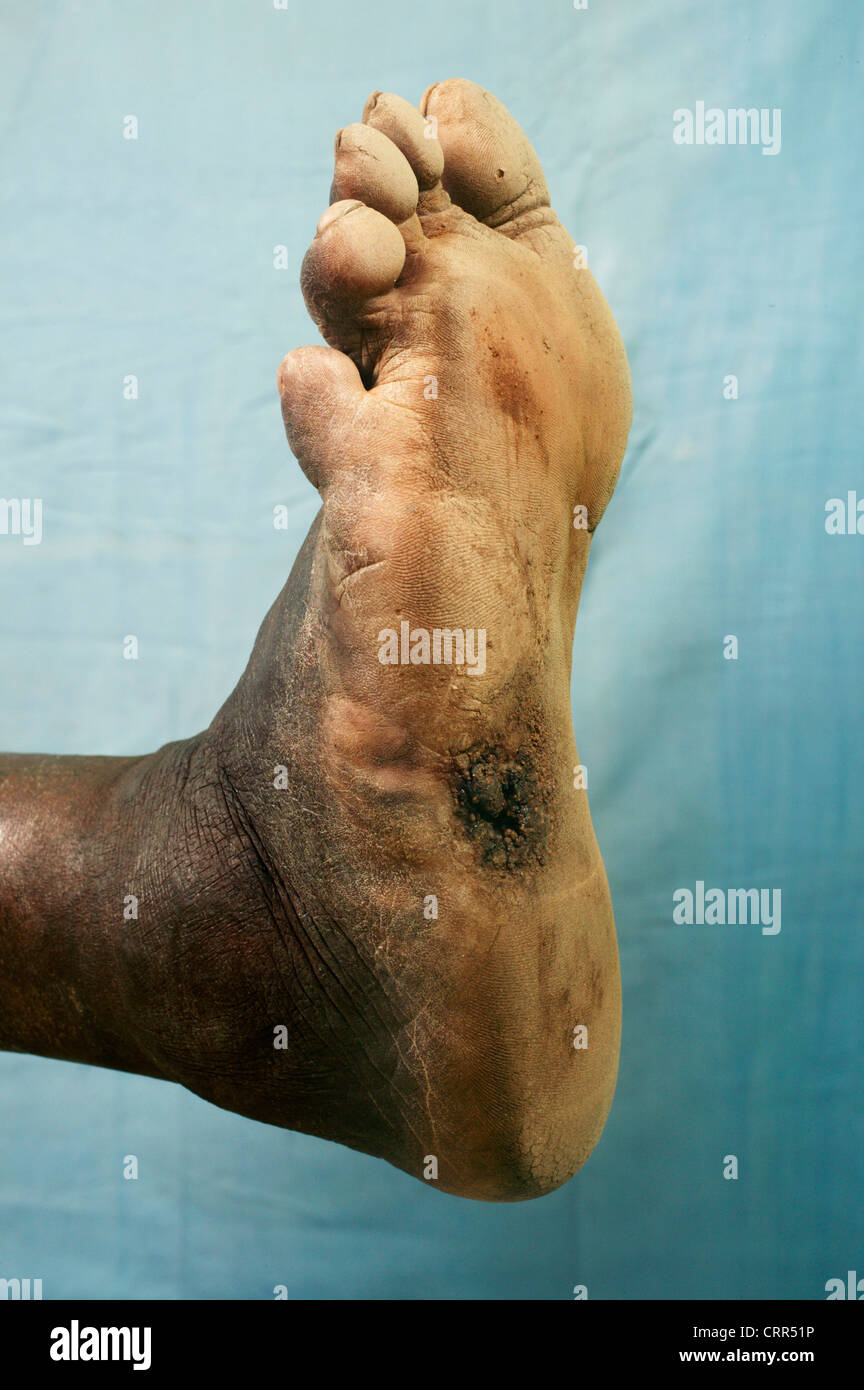 Buerger's Disease Clot Stock Photohttps://www.alamy.com/image-license-details/?v=1https://www.alamy.com/stock-photo-buergers-disease-clot-49066690.html
Buerger's Disease Clot Stock Photohttps://www.alamy.com/image-license-details/?v=1https://www.alamy.com/stock-photo-buergers-disease-clot-49066690.htmlRMCRR51P–Buerger's Disease Clot
 Nocardia bacteria, computer illustration. These are Gram-positive branching filamentous bacteria that fragment into bacillary and coccoid forms, and cause nocardiosis (bacteria formerly identified as Nocardia asteroides complex, that are now separated into several species based on molecular studies, such as N. abscessus, N. cyriacigeorgica, N. nova and other), a rare pulmonary infection that affects people with weakened immune systems. Another type (N. brasiliensis and other) causes actinomycetoma, a tropical skin and bone infection. Stock Photohttps://www.alamy.com/image-license-details/?v=1https://www.alamy.com/nocardia-bacteria-computer-illustration-these-are-gram-positive-branching-filamentous-bacteria-that-fragment-into-bacillary-and-coccoid-forms-and-cause-nocardiosis-bacteria-formerly-identified-as-nocardia-asteroides-complex-that-are-now-separated-into-several-species-based-on-molecular-studies-such-as-n-abscessus-n-cyriacigeorgica-n-nova-and-other-a-rare-pulmonary-infection-that-affects-people-with-weakened-immune-systems-another-type-n-brasiliensis-and-other-causes-actinomycetoma-a-tropical-skin-and-bone-infection-image454450668.html
Nocardia bacteria, computer illustration. These are Gram-positive branching filamentous bacteria that fragment into bacillary and coccoid forms, and cause nocardiosis (bacteria formerly identified as Nocardia asteroides complex, that are now separated into several species based on molecular studies, such as N. abscessus, N. cyriacigeorgica, N. nova and other), a rare pulmonary infection that affects people with weakened immune systems. Another type (N. brasiliensis and other) causes actinomycetoma, a tropical skin and bone infection. Stock Photohttps://www.alamy.com/image-license-details/?v=1https://www.alamy.com/nocardia-bacteria-computer-illustration-these-are-gram-positive-branching-filamentous-bacteria-that-fragment-into-bacillary-and-coccoid-forms-and-cause-nocardiosis-bacteria-formerly-identified-as-nocardia-asteroides-complex-that-are-now-separated-into-several-species-based-on-molecular-studies-such-as-n-abscessus-n-cyriacigeorgica-n-nova-and-other-a-rare-pulmonary-infection-that-affects-people-with-weakened-immune-systems-another-type-n-brasiliensis-and-other-causes-actinomycetoma-a-tropical-skin-and-bone-infection-image454450668.htmlRF2HBA0D0–Nocardia bacteria, computer illustration. These are Gram-positive branching filamentous bacteria that fragment into bacillary and coccoid forms, and cause nocardiosis (bacteria formerly identified as Nocardia asteroides complex, that are now separated into several species based on molecular studies, such as N. abscessus, N. cyriacigeorgica, N. nova and other), a rare pulmonary infection that affects people with weakened immune systems. Another type (N. brasiliensis and other) causes actinomycetoma, a tropical skin and bone infection.
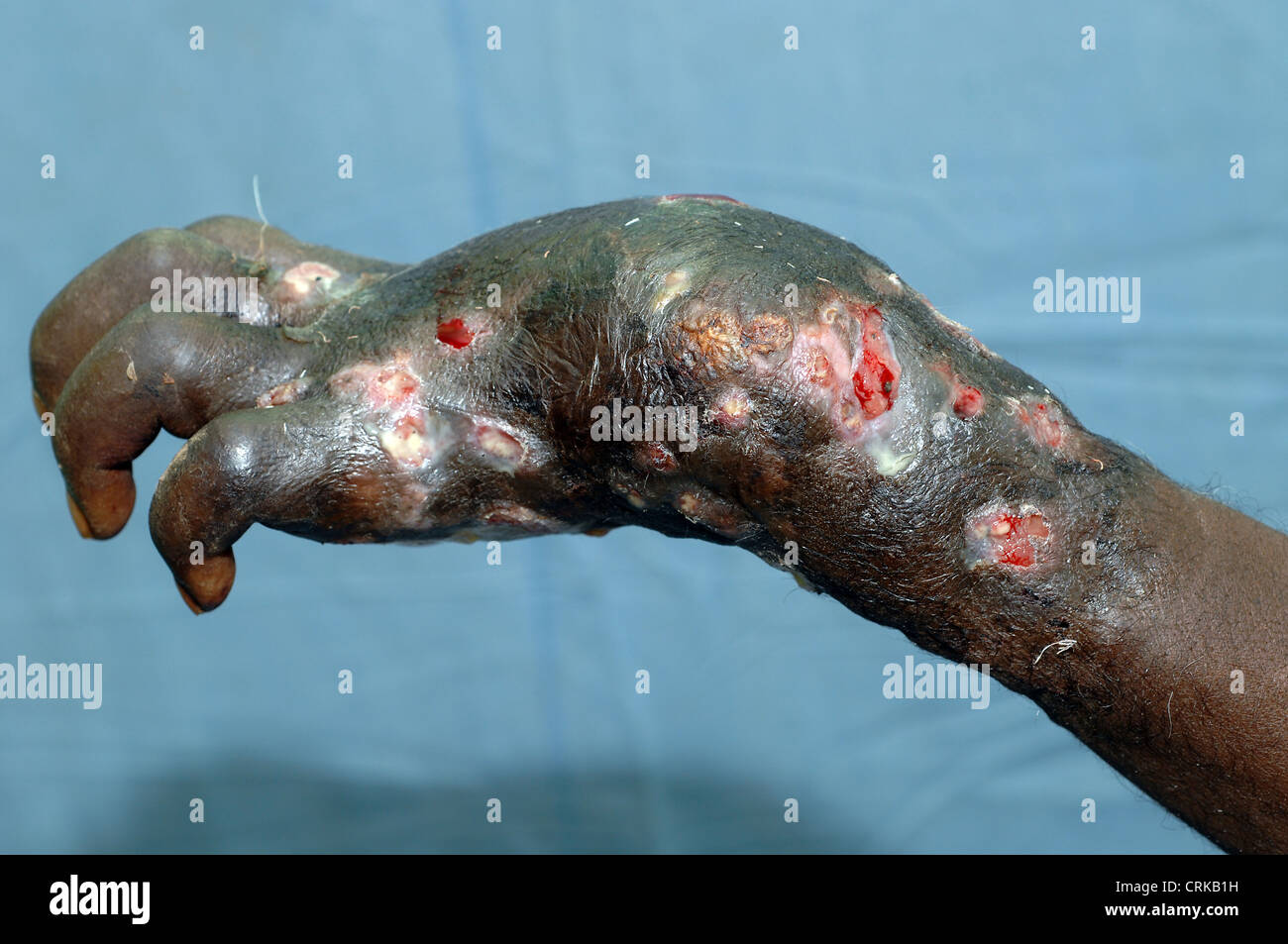 Actinomycetes Actinomycetoma Arm Bacteria Bleeding Diseases Eumycetes Stock Photohttps://www.alamy.com/image-license-details/?v=1https://www.alamy.com/stock-photo-actinomycetes-actinomycetoma-arm-bacteria-bleeding-diseases-eumycetes-48983581.html
Actinomycetes Actinomycetoma Arm Bacteria Bleeding Diseases Eumycetes Stock Photohttps://www.alamy.com/image-license-details/?v=1https://www.alamy.com/stock-photo-actinomycetes-actinomycetoma-arm-bacteria-bleeding-diseases-eumycetes-48983581.htmlRMCRKB1H–Actinomycetes Actinomycetoma Arm Bacteria Bleeding Diseases Eumycetes
 Nocardia bacteria, computer illustration. These are Gram-positive branching filamentous bacteria that fragment into bacillary and coccoid forms, and cause nocardiosis (bacteria formerly identified as Nocardia asteroides complex, that are now separated into several species based on molecular studies, such as N. abscessus, N. cyriacigeorgica, N. nova and other), a rare pulmonary infection that affects people with weakened immune systems. Another type (N. brasiliensis and other) causes actinomycetoma, a tropical skin and bone infection. Stock Photohttps://www.alamy.com/image-license-details/?v=1https://www.alamy.com/nocardia-bacteria-computer-illustration-these-are-gram-positive-branching-filamentous-bacteria-that-fragment-into-bacillary-and-coccoid-forms-and-cause-nocardiosis-bacteria-formerly-identified-as-nocardia-asteroides-complex-that-are-now-separated-into-several-species-based-on-molecular-studies-such-as-n-abscessus-n-cyriacigeorgica-n-nova-and-other-a-rare-pulmonary-infection-that-affects-people-with-weakened-immune-systems-another-type-n-brasiliensis-and-other-causes-actinomycetoma-a-tropical-skin-and-bone-infection-image454450636.html
Nocardia bacteria, computer illustration. These are Gram-positive branching filamentous bacteria that fragment into bacillary and coccoid forms, and cause nocardiosis (bacteria formerly identified as Nocardia asteroides complex, that are now separated into several species based on molecular studies, such as N. abscessus, N. cyriacigeorgica, N. nova and other), a rare pulmonary infection that affects people with weakened immune systems. Another type (N. brasiliensis and other) causes actinomycetoma, a tropical skin and bone infection. Stock Photohttps://www.alamy.com/image-license-details/?v=1https://www.alamy.com/nocardia-bacteria-computer-illustration-these-are-gram-positive-branching-filamentous-bacteria-that-fragment-into-bacillary-and-coccoid-forms-and-cause-nocardiosis-bacteria-formerly-identified-as-nocardia-asteroides-complex-that-are-now-separated-into-several-species-based-on-molecular-studies-such-as-n-abscessus-n-cyriacigeorgica-n-nova-and-other-a-rare-pulmonary-infection-that-affects-people-with-weakened-immune-systems-another-type-n-brasiliensis-and-other-causes-actinomycetoma-a-tropical-skin-and-bone-infection-image454450636.htmlRF2HBA0BT–Nocardia bacteria, computer illustration. These are Gram-positive branching filamentous bacteria that fragment into bacillary and coccoid forms, and cause nocardiosis (bacteria formerly identified as Nocardia asteroides complex, that are now separated into several species based on molecular studies, such as N. abscessus, N. cyriacigeorgica, N. nova and other), a rare pulmonary infection that affects people with weakened immune systems. Another type (N. brasiliensis and other) causes actinomycetoma, a tropical skin and bone infection.
 Actinomycetes Actinomycetoma Arm Bacteria Bleeding Diseases Eumycetes Stock Photohttps://www.alamy.com/image-license-details/?v=1https://www.alamy.com/stock-photo-actinomycetes-actinomycetoma-arm-bacteria-bleeding-diseases-eumycetes-48983569.html
Actinomycetes Actinomycetoma Arm Bacteria Bleeding Diseases Eumycetes Stock Photohttps://www.alamy.com/image-license-details/?v=1https://www.alamy.com/stock-photo-actinomycetes-actinomycetoma-arm-bacteria-bleeding-diseases-eumycetes-48983569.htmlRMCRKB15–Actinomycetes Actinomycetoma Arm Bacteria Bleeding Diseases Eumycetes
 Actinomycetes Actinomycetoma Ankle Bacteria Chronic Granulomatous Disease Stock Photohttps://www.alamy.com/image-license-details/?v=1https://www.alamy.com/stock-photo-actinomycetes-actinomycetoma-ankle-bacteria-chronic-granulomatous-48983189.html
Actinomycetes Actinomycetoma Ankle Bacteria Chronic Granulomatous Disease Stock Photohttps://www.alamy.com/image-license-details/?v=1https://www.alamy.com/stock-photo-actinomycetes-actinomycetoma-ankle-bacteria-chronic-granulomatous-48983189.htmlRMCRKAFH–Actinomycetes Actinomycetoma Ankle Bacteria Chronic Granulomatous Disease
 Actinomycetes Actinomycetoma Bacteria Chronic Granulomatous Disease Stock Photohttps://www.alamy.com/image-license-details/?v=1https://www.alamy.com/stock-photo-actinomycetes-actinomycetoma-bacteria-chronic-granulomatous-disease-48983252.html
Actinomycetes Actinomycetoma Bacteria Chronic Granulomatous Disease Stock Photohttps://www.alamy.com/image-license-details/?v=1https://www.alamy.com/stock-photo-actinomycetes-actinomycetoma-bacteria-chronic-granulomatous-disease-48983252.htmlRMCRKAHT–Actinomycetes Actinomycetoma Bacteria Chronic Granulomatous Disease
 Actinomycetes Actinomycetoma Arm Bacteria Chronic Granulomatous Disease Stock Photohttps://www.alamy.com/image-license-details/?v=1https://www.alamy.com/stock-photo-actinomycetes-actinomycetoma-arm-bacteria-chronic-granulomatous-disease-48983703.html
Actinomycetes Actinomycetoma Arm Bacteria Chronic Granulomatous Disease Stock Photohttps://www.alamy.com/image-license-details/?v=1https://www.alamy.com/stock-photo-actinomycetes-actinomycetoma-arm-bacteria-chronic-granulomatous-disease-48983703.htmlRMCRKB5Y–Actinomycetes Actinomycetoma Arm Bacteria Chronic Granulomatous Disease
 Actinomycetes Actinomycetoma Arm Bacteria Diseases Elderly Hand Male Map Progressive Inflammatory Diseas Sudan Sudanese Tropical Stock Photohttps://www.alamy.com/image-license-details/?v=1https://www.alamy.com/stock-photo-actinomycetes-actinomycetoma-arm-bacteria-diseases-elderly-hand-male-48982972.html
Actinomycetes Actinomycetoma Arm Bacteria Diseases Elderly Hand Male Map Progressive Inflammatory Diseas Sudan Sudanese Tropical Stock Photohttps://www.alamy.com/image-license-details/?v=1https://www.alamy.com/stock-photo-actinomycetes-actinomycetoma-arm-bacteria-diseases-elderly-hand-male-48982972.htmlRMCRKA7T–Actinomycetes Actinomycetoma Arm Bacteria Diseases Elderly Hand Male Map Progressive Inflammatory Diseas Sudan Sudanese Tropical
 ctinomycetes Actinomycetoma Bacteria Chronic Granulomatous Disease Cut Diseases Eumycetes Eumycetoma Fungal Fungi Fungus Hand In Stock Photohttps://www.alamy.com/image-license-details/?v=1https://www.alamy.com/stock-photo-ctinomycetes-actinomycetoma-bacteria-chronic-granulomatous-disease-48982966.html
ctinomycetes Actinomycetoma Bacteria Chronic Granulomatous Disease Cut Diseases Eumycetes Eumycetoma Fungal Fungi Fungus Hand In Stock Photohttps://www.alamy.com/image-license-details/?v=1https://www.alamy.com/stock-photo-ctinomycetes-actinomycetoma-bacteria-chronic-granulomatous-disease-48982966.htmlRMCRKA7J–ctinomycetes Actinomycetoma Bacteria Chronic Granulomatous Disease Cut Diseases Eumycetes Eumycetoma Fungal Fungi Fungus Hand In
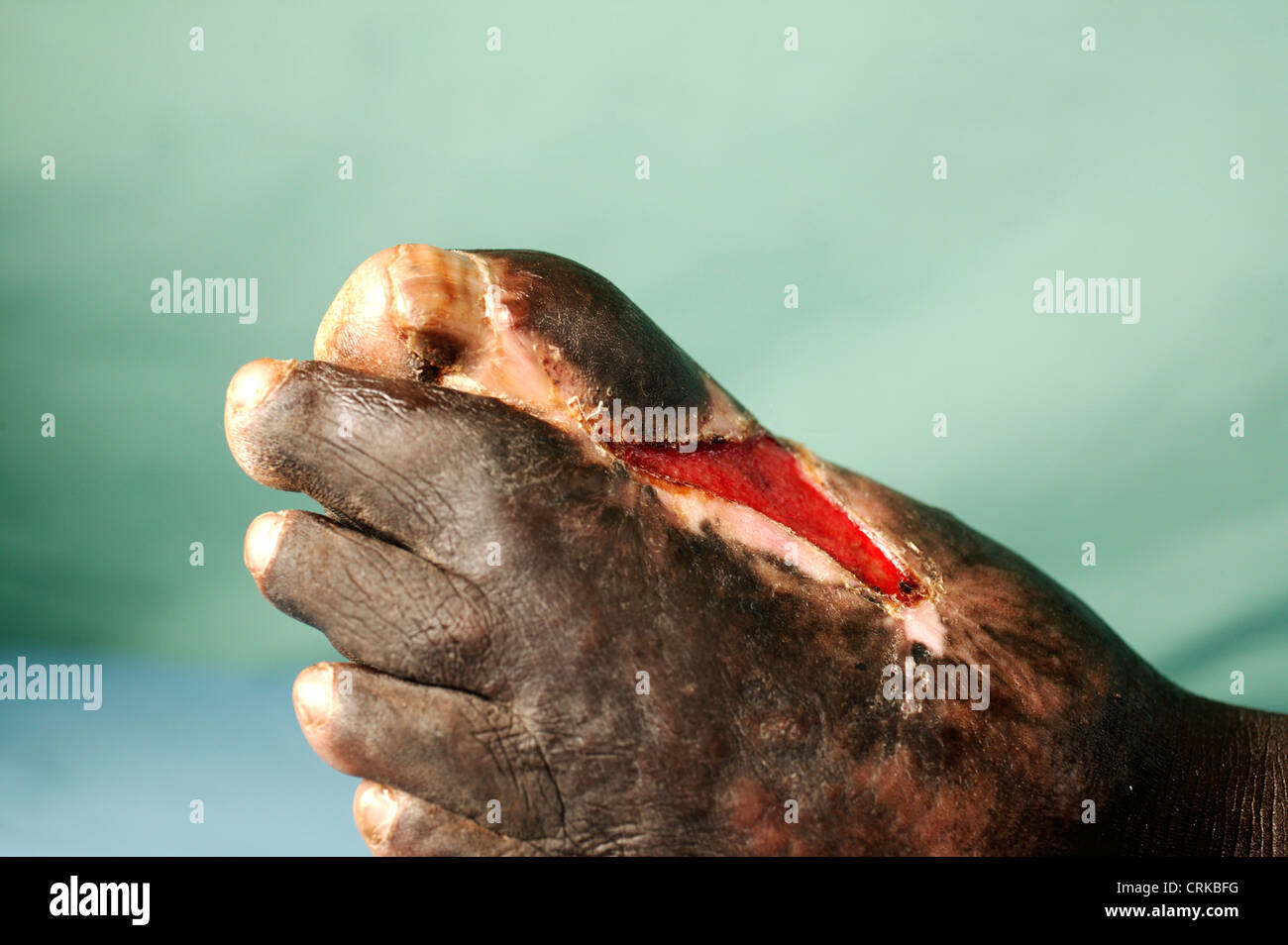 Actinomycetoma of the left foot. Mycetoma is an uncommon disease found in the tropics. It is a chronic, localised infection of the skin and underlying tissues characterised by the formation of several abscesses (collections of pus) and granulomas (collections of epitheloid histiocyte cells produced in an immunologic response to the pathogen) Stock Photohttps://www.alamy.com/image-license-details/?v=1https://www.alamy.com/stock-photo-actinomycetoma-of-the-left-foot-mycetoma-is-an-uncommon-disease-found-48983972.html
Actinomycetoma of the left foot. Mycetoma is an uncommon disease found in the tropics. It is a chronic, localised infection of the skin and underlying tissues characterised by the formation of several abscesses (collections of pus) and granulomas (collections of epitheloid histiocyte cells produced in an immunologic response to the pathogen) Stock Photohttps://www.alamy.com/image-license-details/?v=1https://www.alamy.com/stock-photo-actinomycetoma-of-the-left-foot-mycetoma-is-an-uncommon-disease-found-48983972.htmlRMCRKBFG–Actinomycetoma of the left foot. Mycetoma is an uncommon disease found in the tropics. It is a chronic, localised infection of the skin and underlying tissues characterised by the formation of several abscesses (collections of pus) and granulomas (collections of epitheloid histiocyte cells produced in an immunologic response to the pathogen)
 Actinomycetoma of the left foot. Mycetoma is an uncommon disease found in the tropics. It is a chronic, localised infection of the skin and underlying tissues characterised by the formation of several abscesses (collections of pus) and granulomas (collections of epitheloid histiocyte cells produced in an immunologic response to the pathogen). Th Stock Photohttps://www.alamy.com/image-license-details/?v=1https://www.alamy.com/stock-photo-actinomycetoma-of-the-left-foot-mycetoma-is-an-uncommon-disease-found-48984002.html
Actinomycetoma of the left foot. Mycetoma is an uncommon disease found in the tropics. It is a chronic, localised infection of the skin and underlying tissues characterised by the formation of several abscesses (collections of pus) and granulomas (collections of epitheloid histiocyte cells produced in an immunologic response to the pathogen). Th Stock Photohttps://www.alamy.com/image-license-details/?v=1https://www.alamy.com/stock-photo-actinomycetoma-of-the-left-foot-mycetoma-is-an-uncommon-disease-found-48984002.htmlRMCRKBGJ–Actinomycetoma of the left foot. Mycetoma is an uncommon disease found in the tropics. It is a chronic, localised infection of the skin and underlying tissues characterised by the formation of several abscesses (collections of pus) and granulomas (collections of epitheloid histiocyte cells produced in an immunologic response to the pathogen). Th
 Stock Photohttps://www.alamy.com/image-license-details/?v=1https://www.alamy.com/stock-photo--48983287.html
Stock Photohttps://www.alamy.com/image-license-details/?v=1https://www.alamy.com/stock-photo--48983287.htmlRMCRKAK3–
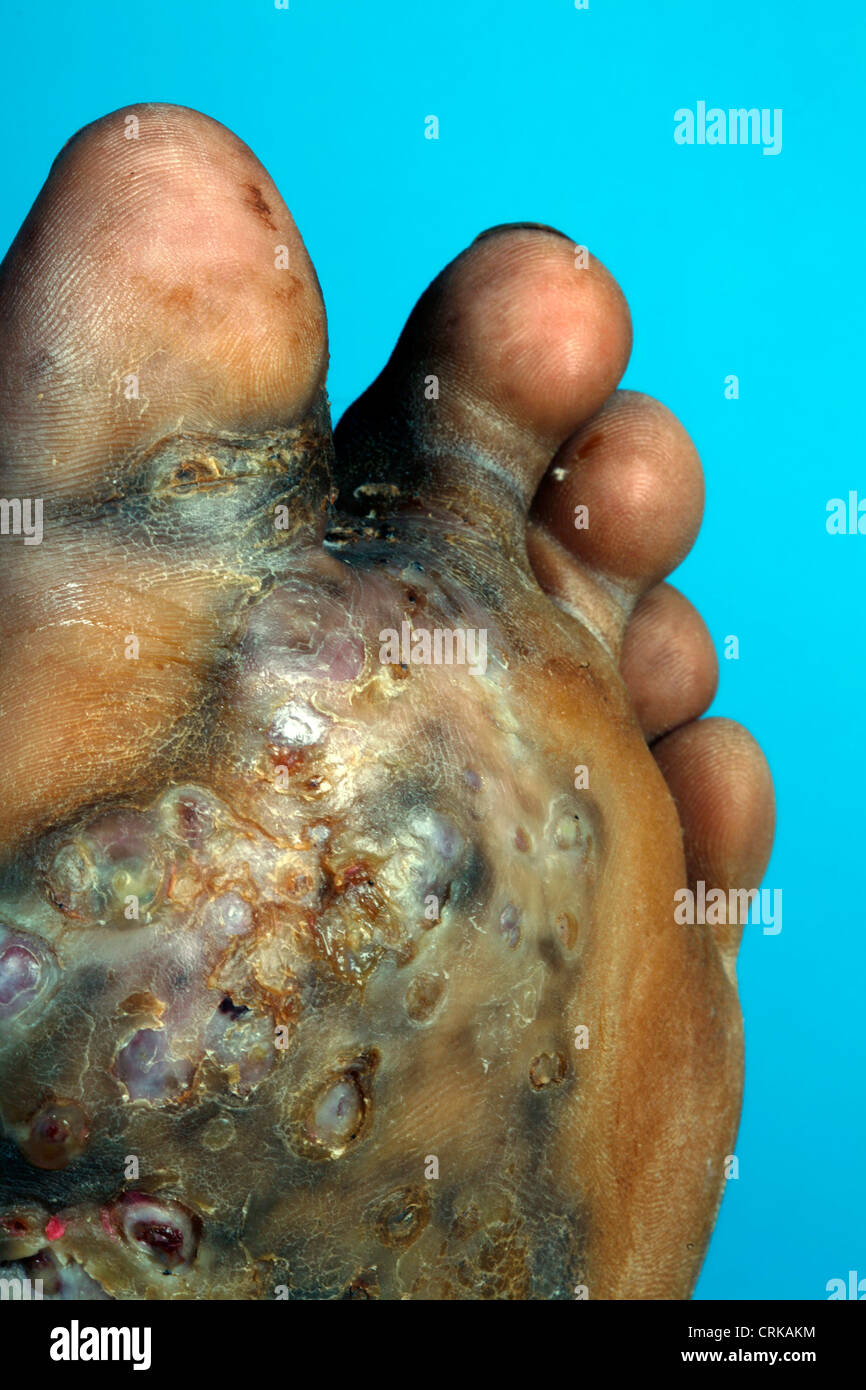 Stock Photohttps://www.alamy.com/image-license-details/?v=1https://www.alamy.com/stock-photo--48983304.html
Stock Photohttps://www.alamy.com/image-license-details/?v=1https://www.alamy.com/stock-photo--48983304.htmlRMCRKAKM–
 Enlarged foot due to Mycetoma Mycetoma is an uncommon disease found in the tropics. It is a chronic, localised infection of the skin and underlying tissues characterised by the formation of several abscesses (collections of pus) and granulomas (collections of epitheloid histiocyte cells produced in an immunologic response to the pathogen). These Stock Photohttps://www.alamy.com/image-license-details/?v=1https://www.alamy.com/stock-photo-enlarged-foot-due-to-mycetoma-mycetoma-is-an-uncommon-disease-found-48983747.html
Enlarged foot due to Mycetoma Mycetoma is an uncommon disease found in the tropics. It is a chronic, localised infection of the skin and underlying tissues characterised by the formation of several abscesses (collections of pus) and granulomas (collections of epitheloid histiocyte cells produced in an immunologic response to the pathogen). These Stock Photohttps://www.alamy.com/image-license-details/?v=1https://www.alamy.com/stock-photo-enlarged-foot-due-to-mycetoma-mycetoma-is-an-uncommon-disease-found-48983747.htmlRMCRKB7F–Enlarged foot due to Mycetoma Mycetoma is an uncommon disease found in the tropics. It is a chronic, localised infection of the skin and underlying tissues characterised by the formation of several abscesses (collections of pus) and granulomas (collections of epitheloid histiocyte cells produced in an immunologic response to the pathogen). These
 Pseudoallescheria Boydii Swelling Stock Photohttps://www.alamy.com/image-license-details/?v=1https://www.alamy.com/stock-photo-pseudoallescheria-boydii-swelling-48981139.html
Pseudoallescheria Boydii Swelling Stock Photohttps://www.alamy.com/image-license-details/?v=1https://www.alamy.com/stock-photo-pseudoallescheria-boydii-swelling-48981139.htmlRMCRK7XB–Pseudoallescheria Boydii Swelling
 Pseudoallescheria Boydii Swelling Stock Photohttps://www.alamy.com/image-license-details/?v=1https://www.alamy.com/stock-photo-pseudoallescheria-boydii-swelling-48981041.html
Pseudoallescheria Boydii Swelling Stock Photohttps://www.alamy.com/image-license-details/?v=1https://www.alamy.com/stock-photo-pseudoallescheria-boydii-swelling-48981041.htmlRMCRK7PW–Pseudoallescheria Boydii Swelling
 Stock Photohttps://www.alamy.com/image-license-details/?v=1https://www.alamy.com/stock-photo--48983028.html
Stock Photohttps://www.alamy.com/image-license-details/?v=1https://www.alamy.com/stock-photo--48983028.htmlRMCRKA9T–
 Stock Photohttps://www.alamy.com/image-license-details/?v=1https://www.alamy.com/stock-photo--48982992.html
Stock Photohttps://www.alamy.com/image-license-details/?v=1https://www.alamy.com/stock-photo--48982992.htmlRMCRKA8G–
 Stock Photohttps://www.alamy.com/image-license-details/?v=1https://www.alamy.com/stock-photo--48982913.html
Stock Photohttps://www.alamy.com/image-license-details/?v=1https://www.alamy.com/stock-photo--48982913.htmlRMCRKA5N–
 Stock Photohttps://www.alamy.com/image-license-details/?v=1https://www.alamy.com/stock-photo--48983482.html
Stock Photohttps://www.alamy.com/image-license-details/?v=1https://www.alamy.com/stock-photo--48983482.htmlRMCRKAX2–
 Stock Photohttps://www.alamy.com/image-license-details/?v=1https://www.alamy.com/stock-photo--48983476.html
Stock Photohttps://www.alamy.com/image-license-details/?v=1https://www.alamy.com/stock-photo--48983476.htmlRMCRKAWT–
 Stock Photohttps://www.alamy.com/image-license-details/?v=1https://www.alamy.com/stock-photo--48983385.html
Stock Photohttps://www.alamy.com/image-license-details/?v=1https://www.alamy.com/stock-photo--48983385.htmlRMCRKAPH–
 Stock Photohttps://www.alamy.com/image-license-details/?v=1https://www.alamy.com/stock-photo--48983111.html
Stock Photohttps://www.alamy.com/image-license-details/?v=1https://www.alamy.com/stock-photo--48983111.htmlRMCRKACR–
 Stock Photohttps://www.alamy.com/image-license-details/?v=1https://www.alamy.com/stock-photo--48983462.html
Stock Photohttps://www.alamy.com/image-license-details/?v=1https://www.alamy.com/stock-photo--48983462.htmlRMCRKAWA–
 Stock Photohttps://www.alamy.com/image-license-details/?v=1https://www.alamy.com/stock-photo--48983416.html
Stock Photohttps://www.alamy.com/image-license-details/?v=1https://www.alamy.com/stock-photo--48983416.htmlRMCRKARM–
 Stock Photohttps://www.alamy.com/image-license-details/?v=1https://www.alamy.com/stock-photo--48982920.html
Stock Photohttps://www.alamy.com/image-license-details/?v=1https://www.alamy.com/stock-photo--48982920.htmlRMCRKA60–
 Stock Photohttps://www.alamy.com/image-license-details/?v=1https://www.alamy.com/stock-photo--48982959.html
Stock Photohttps://www.alamy.com/image-license-details/?v=1https://www.alamy.com/stock-photo--48982959.htmlRMCRKA7B–
 Stock Photohttps://www.alamy.com/image-license-details/?v=1https://www.alamy.com/stock-photo--48983651.html
Stock Photohttps://www.alamy.com/image-license-details/?v=1https://www.alamy.com/stock-photo--48983651.htmlRMCRKB43–
 Stock Photohttps://www.alamy.com/image-license-details/?v=1https://www.alamy.com/stock-photo--48983609.html
Stock Photohttps://www.alamy.com/image-license-details/?v=1https://www.alamy.com/stock-photo--48983609.htmlRMCRKB2H–
 Stock Photohttps://www.alamy.com/image-license-details/?v=1https://www.alamy.com/stock-photo--48983718.html
Stock Photohttps://www.alamy.com/image-license-details/?v=1https://www.alamy.com/stock-photo--48983718.htmlRMCRKB6E–
 Stock Photohttps://www.alamy.com/image-license-details/?v=1https://www.alamy.com/stock-photo--48983451.html
Stock Photohttps://www.alamy.com/image-license-details/?v=1https://www.alamy.com/stock-photo--48983451.htmlRMCRKATY–
 Stock Photohttps://www.alamy.com/image-license-details/?v=1https://www.alamy.com/stock-photo--48983061.html
Stock Photohttps://www.alamy.com/image-license-details/?v=1https://www.alamy.com/stock-photo--48983061.htmlRMCRKAB1–
 Stock Photohttps://www.alamy.com/image-license-details/?v=1https://www.alamy.com/stock-photo--48982915.html
Stock Photohttps://www.alamy.com/image-license-details/?v=1https://www.alamy.com/stock-photo--48982915.htmlRMCRKA5R–
 Stock Photohttps://www.alamy.com/image-license-details/?v=1https://www.alamy.com/stock-photo--48983031.html
Stock Photohttps://www.alamy.com/image-license-details/?v=1https://www.alamy.com/stock-photo--48983031.htmlRMCRKA9Y–
 Stock Photohttps://www.alamy.com/image-license-details/?v=1https://www.alamy.com/stock-photo--48983207.html
Stock Photohttps://www.alamy.com/image-license-details/?v=1https://www.alamy.com/stock-photo--48983207.htmlRMCRKAG7–
 Stock Photohttps://www.alamy.com/image-license-details/?v=1https://www.alamy.com/stock-photo--48983695.html
Stock Photohttps://www.alamy.com/image-license-details/?v=1https://www.alamy.com/stock-photo--48983695.htmlRMCRKB5K–
 Stock Photohttps://www.alamy.com/image-license-details/?v=1https://www.alamy.com/stock-photo--48983617.html
Stock Photohttps://www.alamy.com/image-license-details/?v=1https://www.alamy.com/stock-photo--48983617.htmlRMCRKB2W–
 Stock Photohttps://www.alamy.com/image-license-details/?v=1https://www.alamy.com/stock-photo--48982895.html
Stock Photohttps://www.alamy.com/image-license-details/?v=1https://www.alamy.com/stock-photo--48982895.htmlRMCRKA53–
 Stock Photohttps://www.alamy.com/image-license-details/?v=1https://www.alamy.com/stock-photo--48983591.html
Stock Photohttps://www.alamy.com/image-license-details/?v=1https://www.alamy.com/stock-photo--48983591.htmlRMCRKB1Y–
 Stock Photohttps://www.alamy.com/image-license-details/?v=1https://www.alamy.com/stock-photo--48983407.html
Stock Photohttps://www.alamy.com/image-license-details/?v=1https://www.alamy.com/stock-photo--48983407.htmlRMCRKARB–
 Stock Photohttps://www.alamy.com/image-license-details/?v=1https://www.alamy.com/stock-photo--48983119.html
Stock Photohttps://www.alamy.com/image-license-details/?v=1https://www.alamy.com/stock-photo--48983119.htmlRMCRKAD3–
 Stock Photohttps://www.alamy.com/image-license-details/?v=1https://www.alamy.com/stock-photo--48983699.html
Stock Photohttps://www.alamy.com/image-license-details/?v=1https://www.alamy.com/stock-photo--48983699.htmlRMCRKB5R–
 Mycetoma Progressive Inflammatory Diseas Soft Tissue Granuloma Swelling Swollen Toe Toes Stock Photohttps://www.alamy.com/image-license-details/?v=1https://www.alamy.com/stock-photo-mycetoma-progressive-inflammatory-diseas-soft-tissue-granuloma-swelling-48983214.html
Mycetoma Progressive Inflammatory Diseas Soft Tissue Granuloma Swelling Swollen Toe Toes Stock Photohttps://www.alamy.com/image-license-details/?v=1https://www.alamy.com/stock-photo-mycetoma-progressive-inflammatory-diseas-soft-tissue-granuloma-swelling-48983214.htmlRMCRKAGE–Mycetoma Progressive Inflammatory Diseas Soft Tissue Granuloma Swelling Swollen Toe Toes
 Stock Photohttps://www.alamy.com/image-license-details/?v=1https://www.alamy.com/stock-photo--48983412.html
Stock Photohttps://www.alamy.com/image-license-details/?v=1https://www.alamy.com/stock-photo--48983412.htmlRMCRKARG–
 Stock Photohttps://www.alamy.com/image-license-details/?v=1https://www.alamy.com/stock-photo--48982892.html
Stock Photohttps://www.alamy.com/image-license-details/?v=1https://www.alamy.com/stock-photo--48982892.htmlRMCRKA50–
 Stock Photohttps://www.alamy.com/image-license-details/?v=1https://www.alamy.com/stock-photo--48982890.html
Stock Photohttps://www.alamy.com/image-license-details/?v=1https://www.alamy.com/stock-photo--48982890.htmlRMCRKA4X–
 Stock Photohttps://www.alamy.com/image-license-details/?v=1https://www.alamy.com/stock-photo--48983352.html
Stock Photohttps://www.alamy.com/image-license-details/?v=1https://www.alamy.com/stock-photo--48983352.htmlRMCRKANC–
 Stock Photohttps://www.alamy.com/image-license-details/?v=1https://www.alamy.com/stock-photo--48983162.html
Stock Photohttps://www.alamy.com/image-license-details/?v=1https://www.alamy.com/stock-photo--48983162.htmlRMCRKAEJ–
 Stock Photohttps://www.alamy.com/image-license-details/?v=1https://www.alamy.com/stock-photo--48983335.html
Stock Photohttps://www.alamy.com/image-license-details/?v=1https://www.alamy.com/stock-photo--48983335.htmlRMCRKAMR–
 Stock Photohttps://www.alamy.com/image-license-details/?v=1https://www.alamy.com/stock-photo--48983668.html
Stock Photohttps://www.alamy.com/image-license-details/?v=1https://www.alamy.com/stock-photo--48983668.htmlRMCRKB4M–
 Stock Photohttps://www.alamy.com/image-license-details/?v=1https://www.alamy.com/stock-photo--48982944.html
Stock Photohttps://www.alamy.com/image-license-details/?v=1https://www.alamy.com/stock-photo--48982944.htmlRMCRKA6T–
 Stock Photohttps://www.alamy.com/image-license-details/?v=1https://www.alamy.com/stock-photo--48983382.html
Stock Photohttps://www.alamy.com/image-license-details/?v=1https://www.alamy.com/stock-photo--48983382.htmlRMCRKAPE–
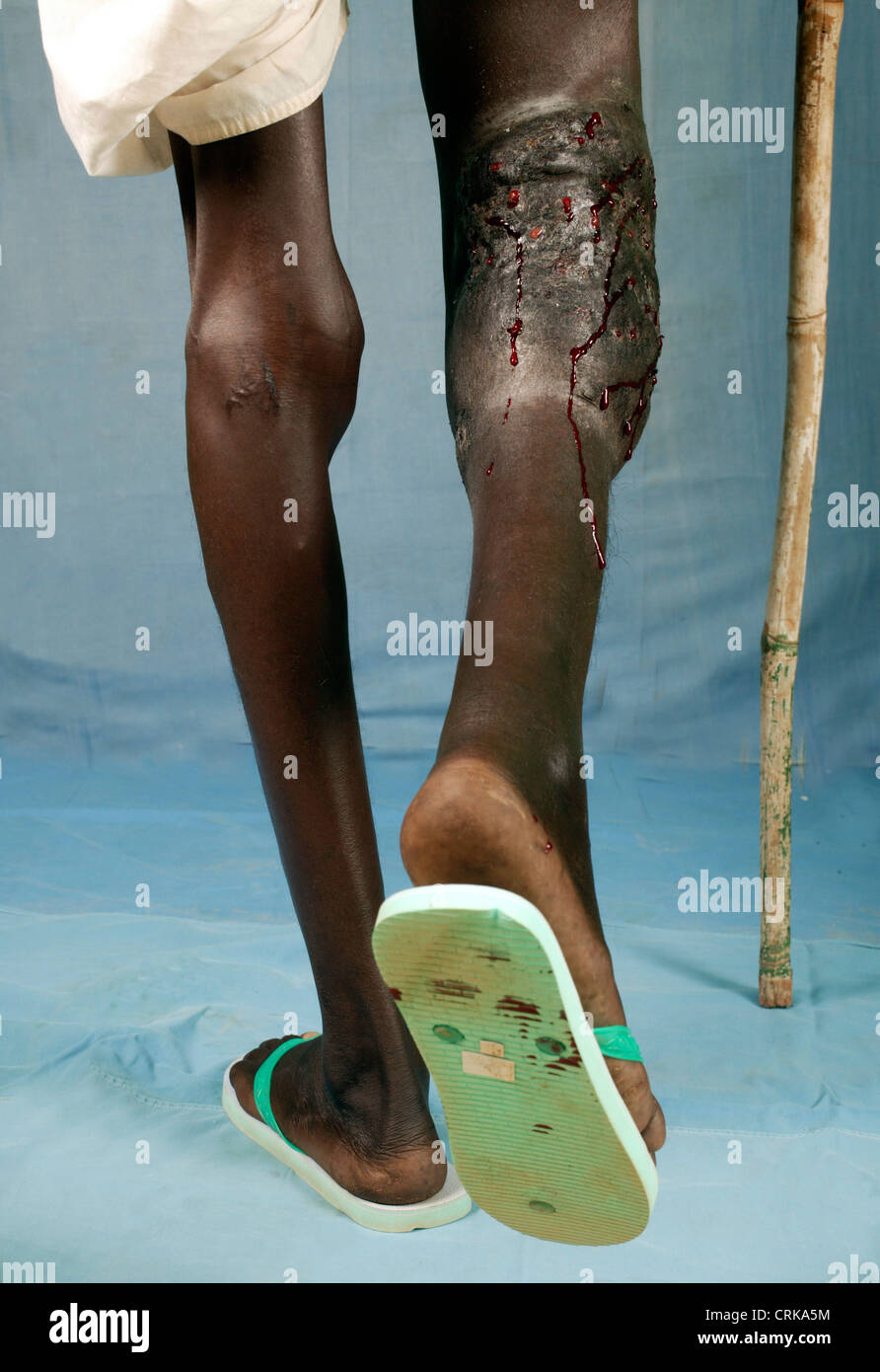 Stock Photohttps://www.alamy.com/image-license-details/?v=1https://www.alamy.com/stock-photo--48982912.html
Stock Photohttps://www.alamy.com/image-license-details/?v=1https://www.alamy.com/stock-photo--48982912.htmlRMCRKA5M–
 Stock Photohttps://www.alamy.com/image-license-details/?v=1https://www.alamy.com/stock-photo--48983667.html
Stock Photohttps://www.alamy.com/image-license-details/?v=1https://www.alamy.com/stock-photo--48983667.htmlRMCRKB4K–

